Does Warfarin Increase Subdural Haemorrhage Risk? A Systematic Review
VerifiedAdded on 2021/06/17
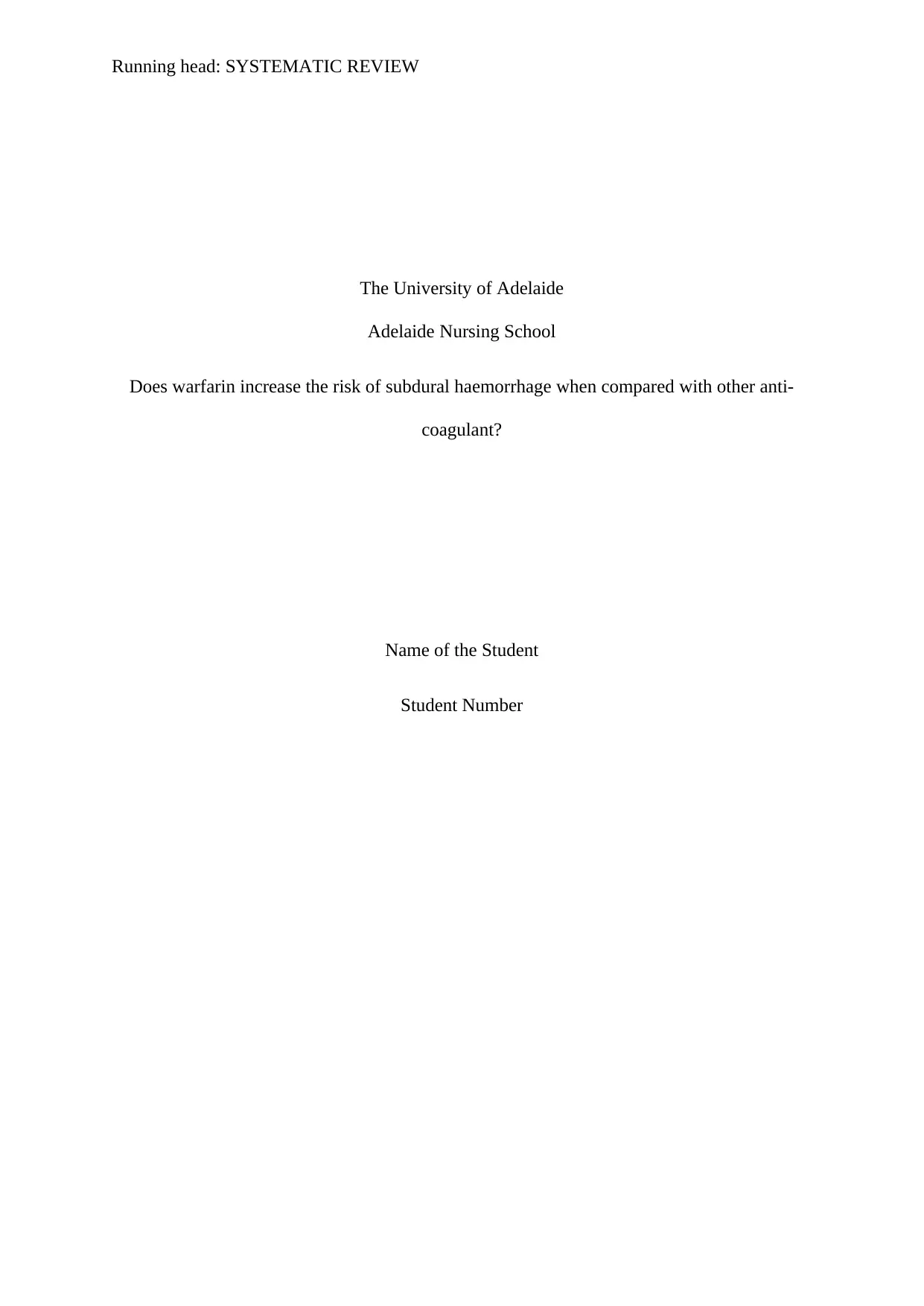
The University of Adelaide
Adelaide Nursing School
Does warfarin increase the risk of subdural haemorrhage when compared with other anti-
coagulant?
Name of the Student
Student Number
Paraphrase This Document
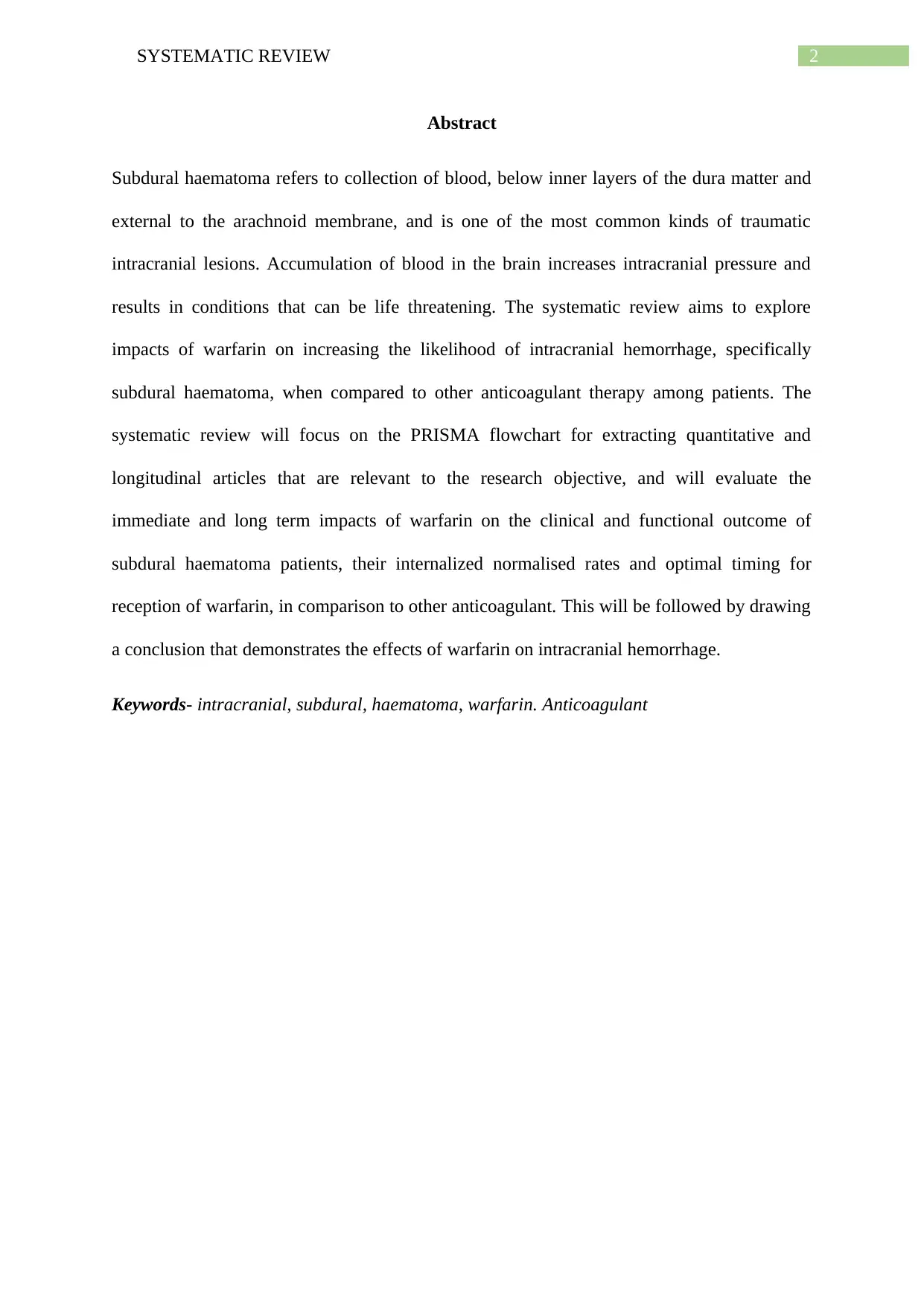
Abstract
Subdural haematoma refers to collection of blood, below inner layers of the dura matter and
external to the arachnoid membrane, and is one of the most common kinds of traumatic
intracranial lesions. Accumulation of blood in the brain increases intracranial pressure and
results in conditions that can be life threatening. The systematic review aims to explore
impacts of warfarin on increasing the likelihood of intracranial hemorrhage, specifically
subdural haematoma, when compared to other anticoagulant therapy among patients. The
systematic review will focus on the PRISMA flowchart for extracting quantitative and
longitudinal articles that are relevant to the research objective, and will evaluate the
immediate and long term impacts of warfarin on the clinical and functional outcome of
subdural haematoma patients, their internalized normalised rates and optimal timing for
reception of warfarin, in comparison to other anticoagulant. This will be followed by drawing
a conclusion that demonstrates the effects of warfarin on intracranial hemorrhage.
Keywords- intracranial, subdural, haematoma, warfarin. Anticoagulant
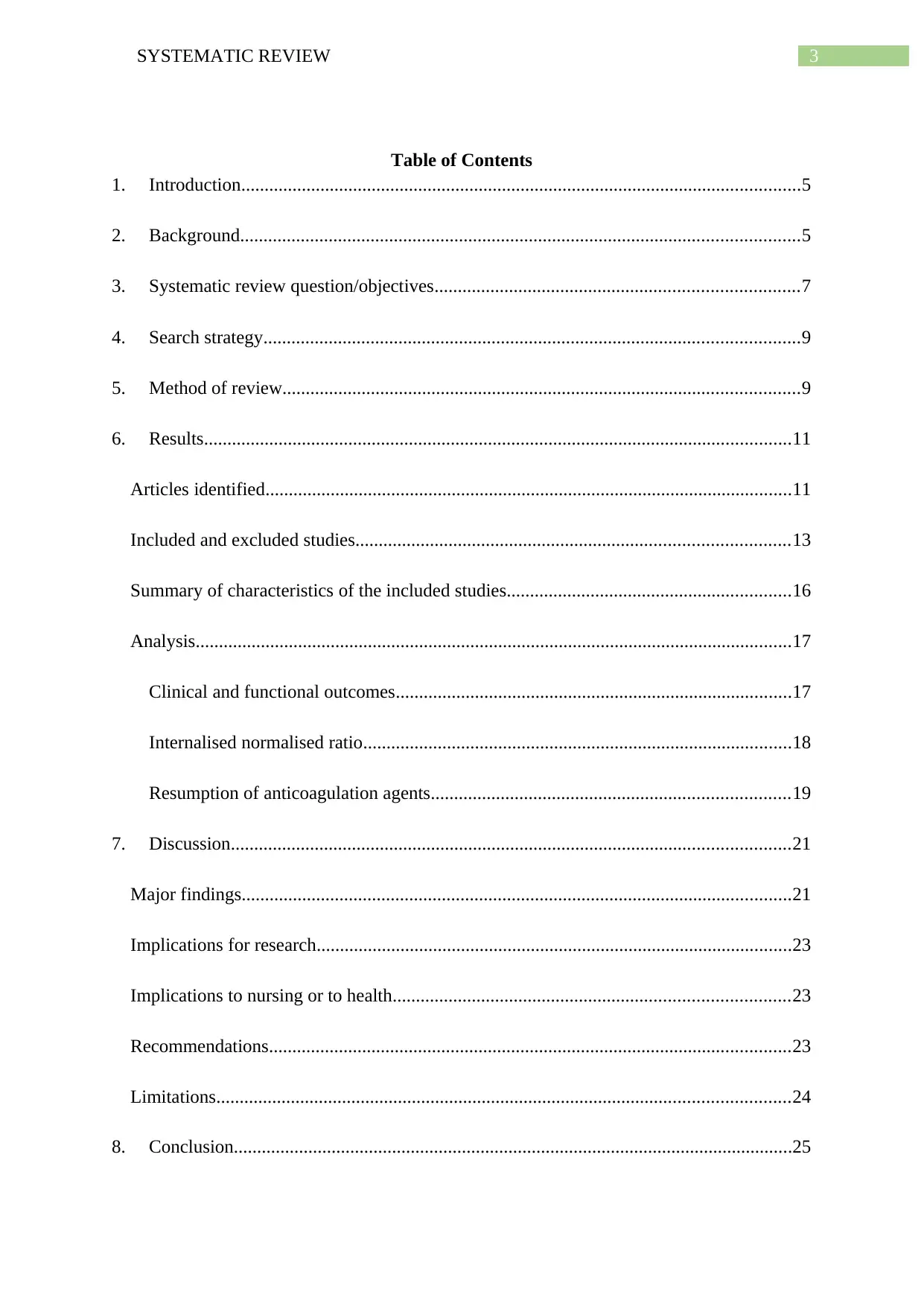
Table of Contents
1. Introduction........................................................................................................................5
2. Background........................................................................................................................5
3. Systematic review question/objectives..............................................................................7
4. Search strategy...................................................................................................................9
5. Method of review...............................................................................................................9
6. Results..............................................................................................................................11
Articles identified.................................................................................................................11
Included and excluded studies.............................................................................................13
Summary of characteristics of the included studies.............................................................16
Analysis................................................................................................................................17
Clinical and functional outcomes.....................................................................................17
Internalised normalised ratio............................................................................................18
Resumption of anticoagulation agents.............................................................................19
7. Discussion........................................................................................................................21
Major findings......................................................................................................................21
Implications for research......................................................................................................23
Implications to nursing or to health.....................................................................................23
Recommendations................................................................................................................23
Limitations...........................................................................................................................24
8. Conclusion........................................................................................................................25
⊘ This is a preview!⊘
Do you want full access?
Subscribe today to unlock all pages.

Trusted by 1+ million students worldwide

References................................................................................................................................27
Paraphrase This Document
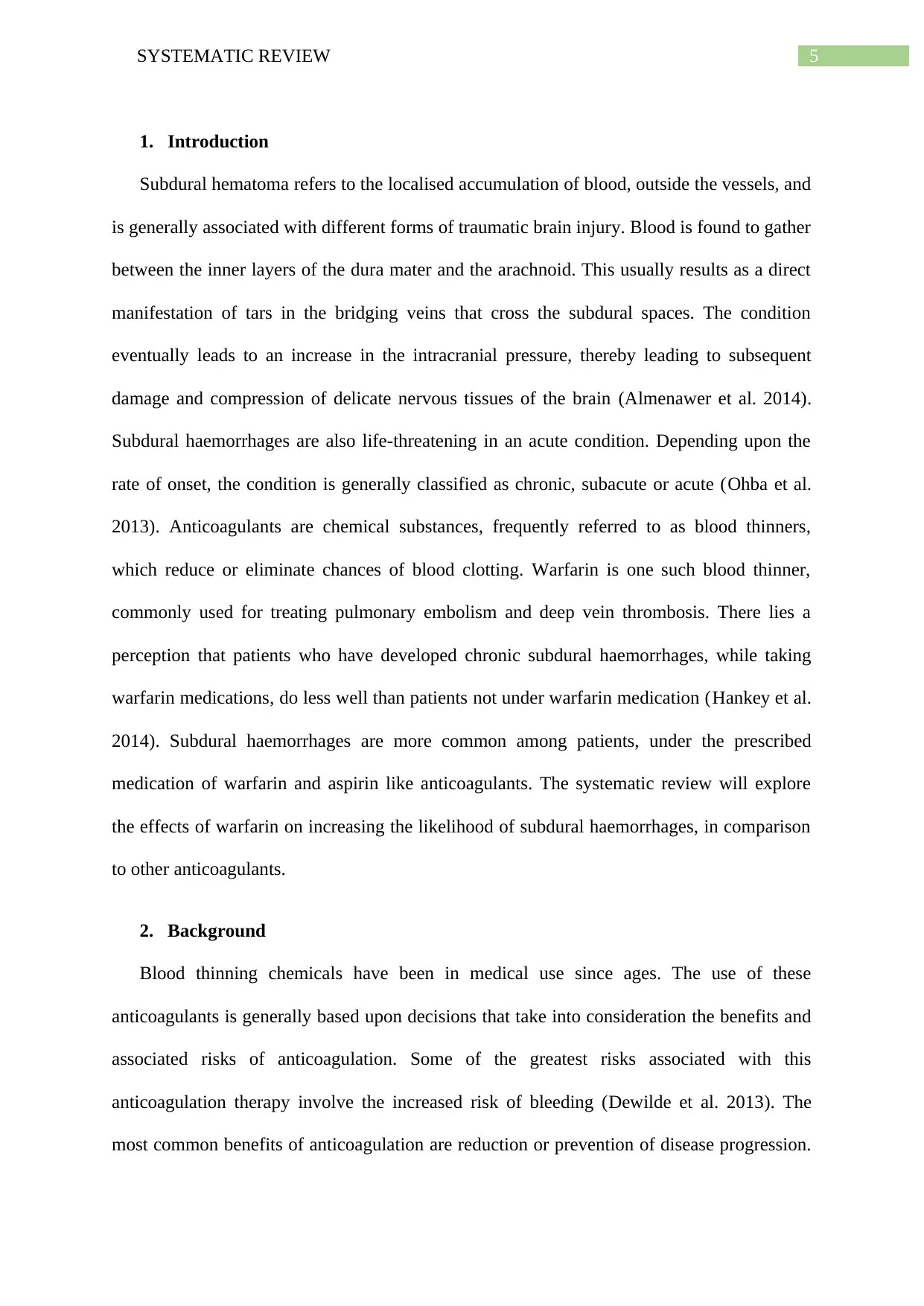
1. Introduction
Subdural hematoma refers to the localised accumulation of blood, outside the vessels, and
is generally associated with different forms of traumatic brain injury. Blood is found to gather
between the inner layers of the dura mater and the arachnoid. This usually results as a direct
manifestation of tars in the bridging veins that cross the subdural spaces. The condition
eventually leads to an increase in the intracranial pressure, thereby leading to subsequent
damage and compression of delicate nervous tissues of the brain (Almenawer et al. 2014).
Subdural haemorrhages are also life-threatening in an acute condition. Depending upon the
rate of onset, the condition is generally classified as chronic, subacute or acute (Ohba et al.
2013). Anticoagulants are chemical substances, frequently referred to as blood thinners,
which reduce or eliminate chances of blood clotting. Warfarin is one such blood thinner,
commonly used for treating pulmonary embolism and deep vein thrombosis. There lies a
perception that patients who have developed chronic subdural haemorrhages, while taking
warfarin medications, do less well than patients not under warfarin medication (Hankey et al.
2014). Subdural haemorrhages are more common among patients, under the prescribed
medication of warfarin and aspirin like anticoagulants. The systematic review will explore
the effects of warfarin on increasing the likelihood of subdural haemorrhages, in comparison
to other anticoagulants.
2. Background
Blood thinning chemicals have been in medical use since ages. The use of these
anticoagulants is generally based upon decisions that take into consideration the benefits and
associated risks of anticoagulation. Some of the greatest risks associated with this
anticoagulation therapy involve the increased risk of bleeding (Dewilde et al. 2013). The
most common benefits of anticoagulation are reduction or prevention of disease progression.
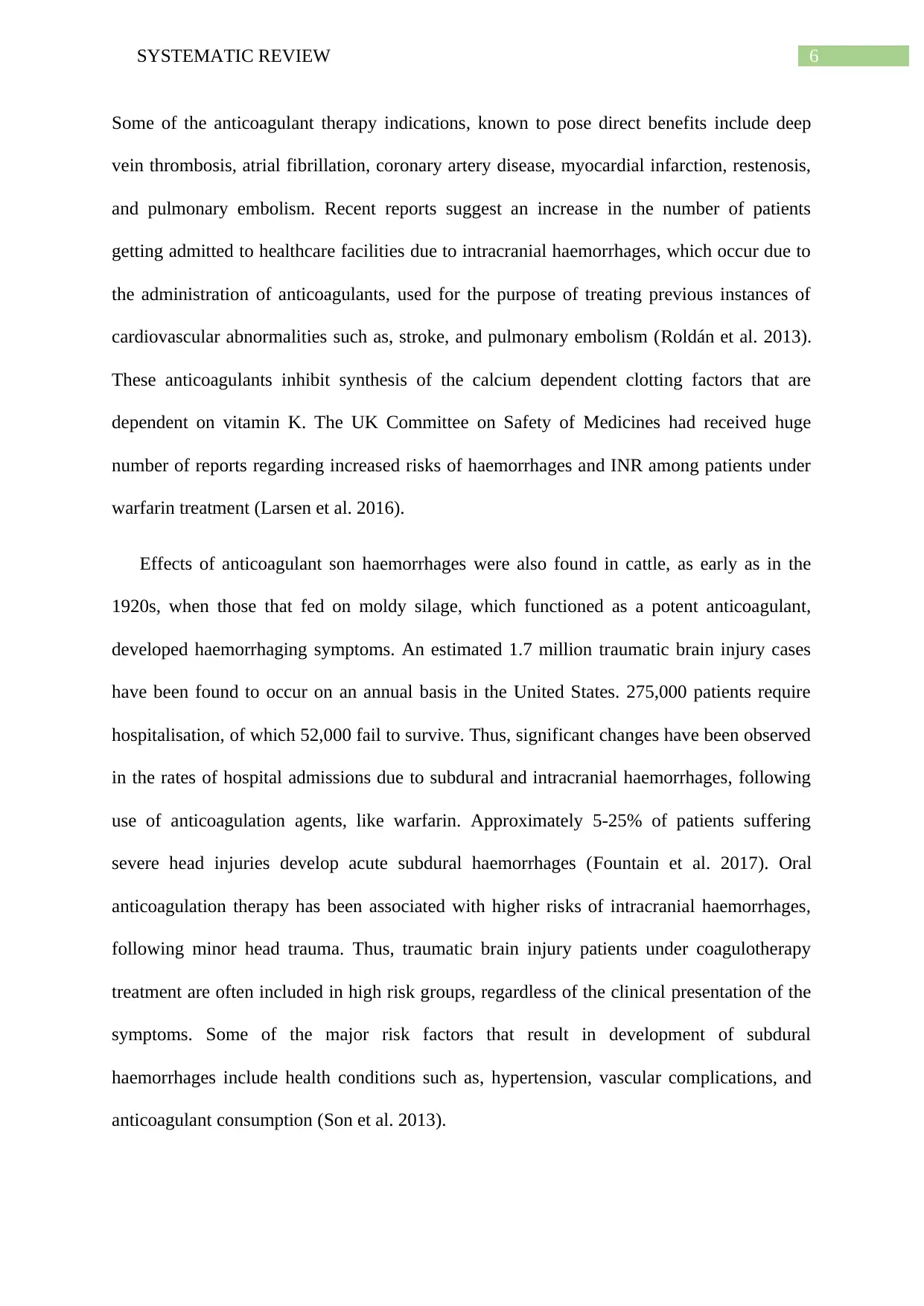
Some of the anticoagulant therapy indications, known to pose direct benefits include deep
vein thrombosis, atrial fibrillation, coronary artery disease, myocardial infarction, restenosis,
and pulmonary embolism. Recent reports suggest an increase in the number of patients
getting admitted to healthcare facilities due to intracranial haemorrhages, which occur due to
the administration of anticoagulants, used for the purpose of treating previous instances of
cardiovascular abnormalities such as, stroke, and pulmonary embolism (Roldán et al. 2013).
These anticoagulants inhibit synthesis of the calcium dependent clotting factors that are
dependent on vitamin K. The UK Committee on Safety of Medicines had received huge
number of reports regarding increased risks of haemorrhages and INR among patients under
warfarin treatment (Larsen et al. 2016).
Effects of anticoagulant son haemorrhages were also found in cattle, as early as in the
1920s, when those that fed on moldy silage, which functioned as a potent anticoagulant,
developed haemorrhaging symptoms. An estimated 1.7 million traumatic brain injury cases
have been found to occur on an annual basis in the United States. 275,000 patients require
hospitalisation, of which 52,000 fail to survive. Thus, significant changes have been observed
in the rates of hospital admissions due to subdural and intracranial haemorrhages, following
use of anticoagulation agents, like warfarin. Approximately 5-25% of patients suffering
severe head injuries develop acute subdural haemorrhages (Fountain et al. 2017). Oral
anticoagulation therapy has been associated with higher risks of intracranial haemorrhages,
following minor head trauma. Thus, traumatic brain injury patients under coagulotherapy
treatment are often included in high risk groups, regardless of the clinical presentation of the
symptoms. Some of the major risk factors that result in development of subdural
haemorrhages include health conditions such as, hypertension, vascular complications, and
anticoagulant consumption (Son et al. 2013).
⊘ This is a preview!⊘
Do you want full access?
Subscribe today to unlock all pages.

Trusted by 1+ million students worldwide
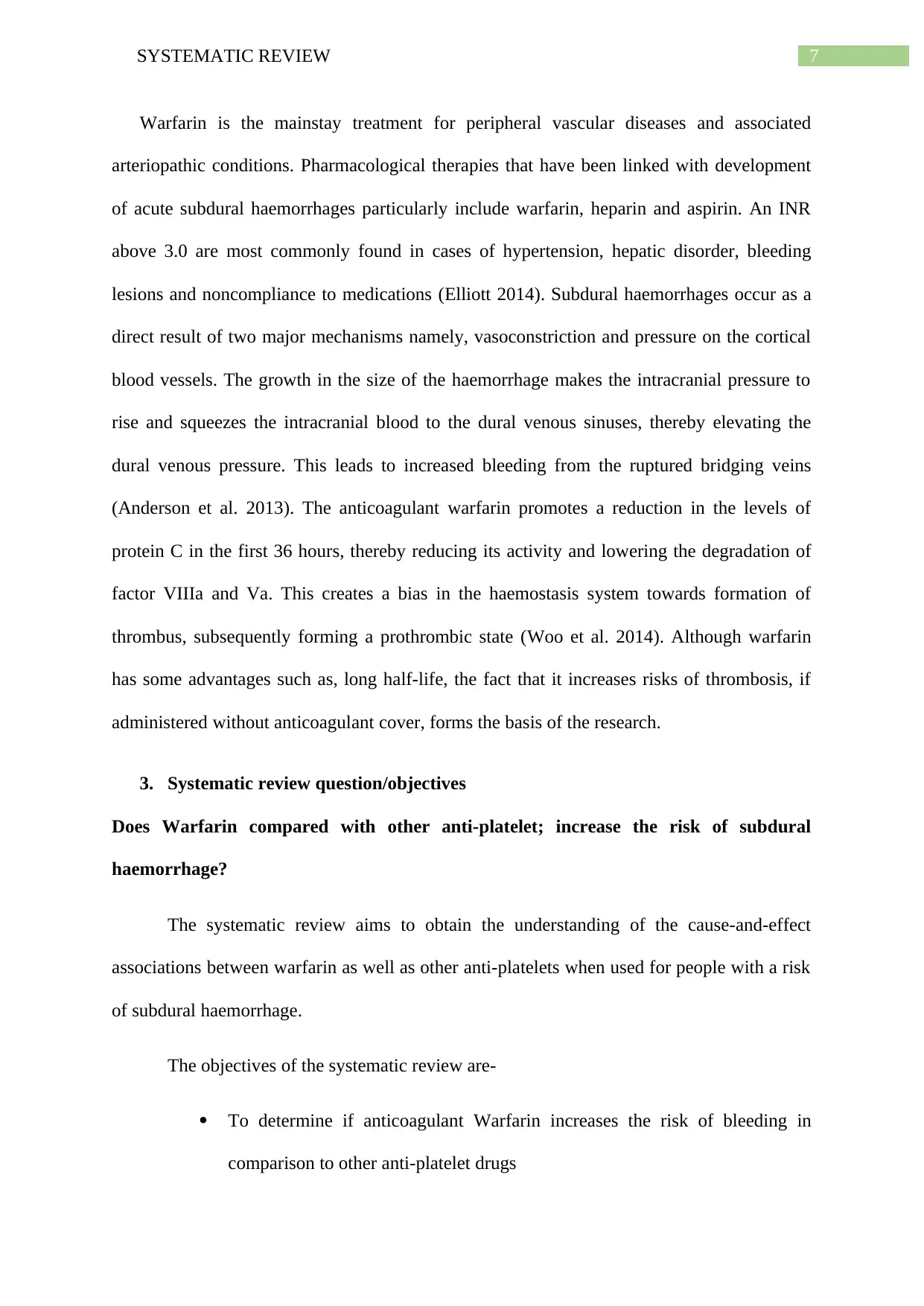
Warfarin is the mainstay treatment for peripheral vascular diseases and associated
arteriopathic conditions. Pharmacological therapies that have been linked with development
of acute subdural haemorrhages particularly include warfarin, heparin and aspirin. An INR
above 3.0 are most commonly found in cases of hypertension, hepatic disorder, bleeding
lesions and noncompliance to medications (Elliott 2014). Subdural haemorrhages occur as a
direct result of two major mechanisms namely, vasoconstriction and pressure on the cortical
blood vessels. The growth in the size of the haemorrhage makes the intracranial pressure to
rise and squeezes the intracranial blood to the dural venous sinuses, thereby elevating the
dural venous pressure. This leads to increased bleeding from the ruptured bridging veins
(Anderson et al. 2013). The anticoagulant warfarin promotes a reduction in the levels of
protein C in the first 36 hours, thereby reducing its activity and lowering the degradation of
factor VIIIa and Va. This creates a bias in the haemostasis system towards formation of
thrombus, subsequently forming a prothrombic state (Woo et al. 2014). Although warfarin
has some advantages such as, long half-life, the fact that it increases risks of thrombosis, if
administered without anticoagulant cover, forms the basis of the research.
3. Systematic review question/objectives
Does Warfarin compared with other anti-platelet; increase the risk of subdural
haemorrhage?
The systematic review aims to obtain the understanding of the cause-and-effect
associations between warfarin as well as other anti-platelets when used for people with a risk
of subdural haemorrhage.
The objectives of the systematic review are-
To determine if anticoagulant Warfarin increases the risk of bleeding in
comparison to other anti-platelet drugs
Paraphrase This Document
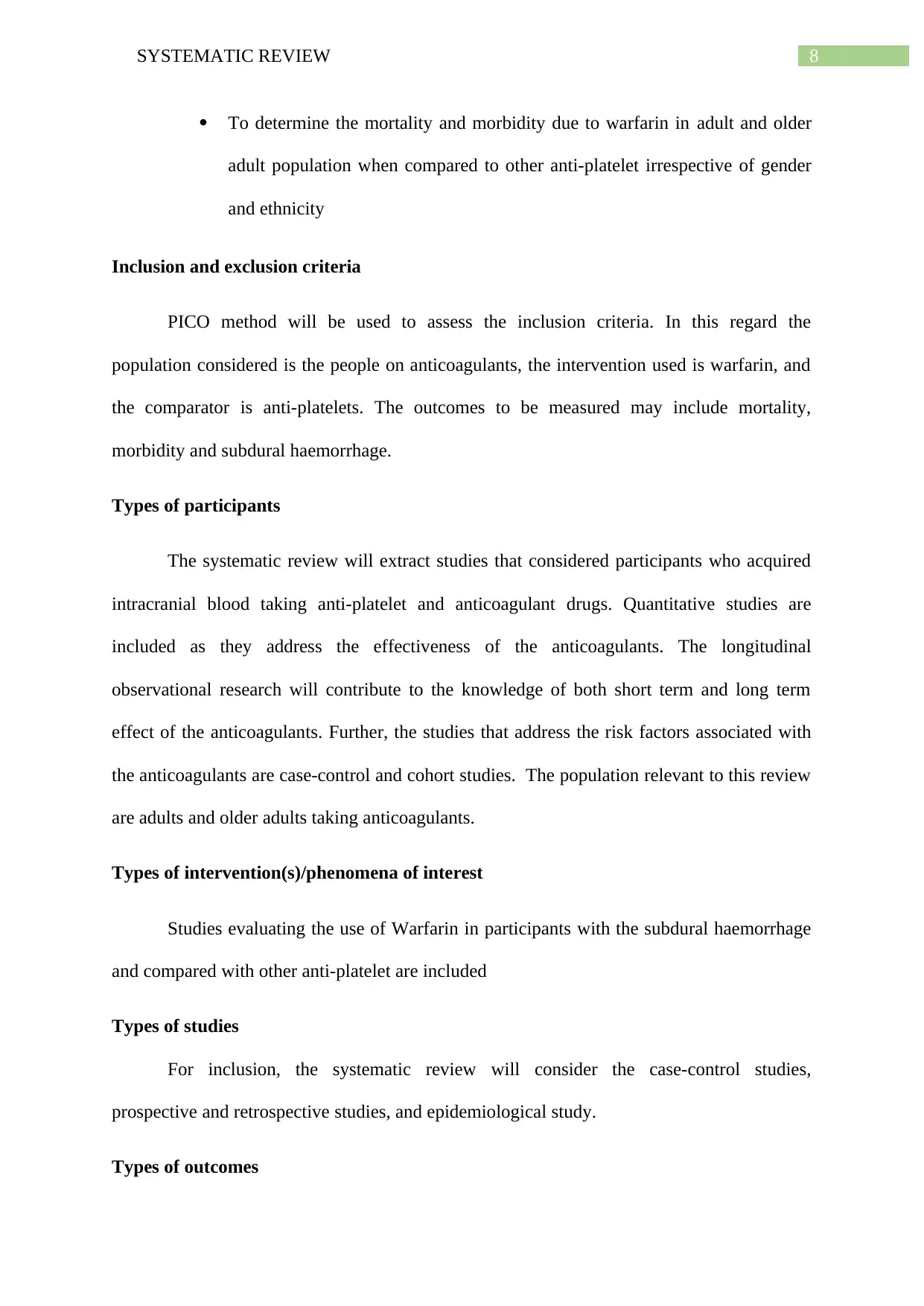
To determine the mortality and morbidity due to warfarin in adult and older
adult population when compared to other anti-platelet irrespective of gender
and ethnicity
Inclusion and exclusion criteria
PICO method will be used to assess the inclusion criteria. In this regard the
population considered is the people on anticoagulants, the intervention used is warfarin, and
the comparator is anti-platelets. The outcomes to be measured may include mortality,
morbidity and subdural haemorrhage.
Types of participants
The systematic review will extract studies that considered participants who acquired
intracranial blood taking anti-platelet and anticoagulant drugs. Quantitative studies are
included as they address the effectiveness of the anticoagulants. The longitudinal
observational research will contribute to the knowledge of both short term and long term
effect of the anticoagulants. Further, the studies that address the risk factors associated with
the anticoagulants are case-control and cohort studies. The population relevant to this review
are adults and older adults taking anticoagulants.
Types of intervention(s)/phenomena of interest
Studies evaluating the use of Warfarin in participants with the subdural haemorrhage
and compared with other anti-platelet are included
Types of studies
For inclusion, the systematic review will consider the case-control studies,
prospective and retrospective studies, and epidemiological study.
Types of outcomes
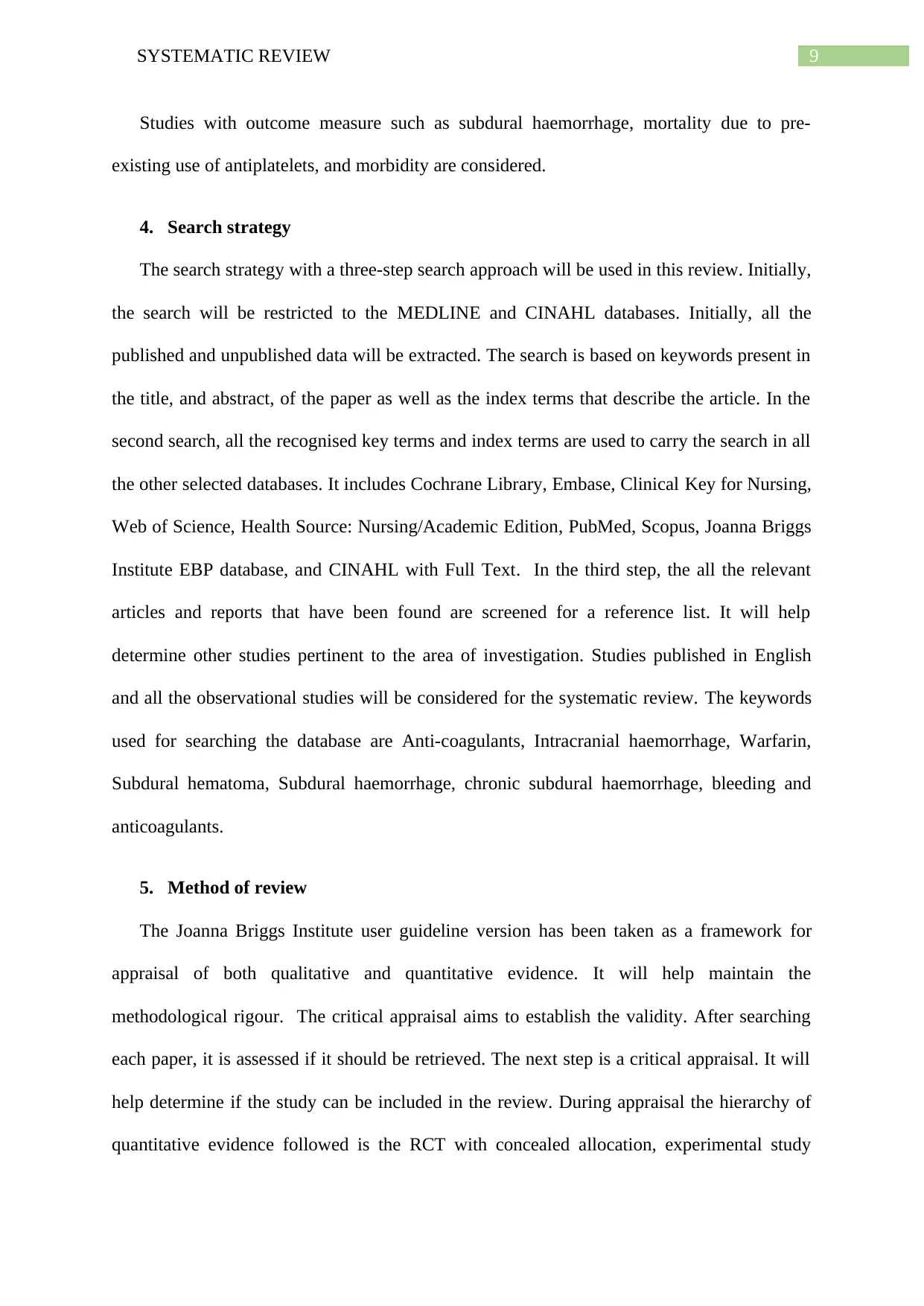
Studies with outcome measure such as subdural haemorrhage, mortality due to pre-
existing use of antiplatelets, and morbidity are considered.
4. Search strategy
The search strategy with a three-step search approach will be used in this review. Initially,
the search will be restricted to the MEDLINE and CINAHL databases. Initially, all the
published and unpublished data will be extracted. The search is based on keywords present in
the title, and abstract, of the paper as well as the index terms that describe the article. In the
second search, all the recognised key terms and index terms are used to carry the search in all
the other selected databases. It includes Cochrane Library, Embase, Clinical Key for Nursing,
Web of Science, Health Source: Nursing/Academic Edition, PubMed, Scopus, Joanna Briggs
Institute EBP database, and CINAHL with Full Text. In the third step, the all the relevant
articles and reports that have been found are screened for a reference list. It will help
determine other studies pertinent to the area of investigation. Studies published in English
and all the observational studies will be considered for the systematic review. The keywords
used for searching the database are Anti-coagulants, Intracranial haemorrhage, Warfarin,
Subdural hematoma, Subdural haemorrhage, chronic subdural haemorrhage, bleeding and
anticoagulants.
5. Method of review
The Joanna Briggs Institute user guideline version has been taken as a framework for
appraisal of both qualitative and quantitative evidence. It will help maintain the
methodological rigour. The critical appraisal aims to establish the validity. After searching
each paper, it is assessed if it should be retrieved. The next step is a critical appraisal. It will
help determine if the study can be included in the review. During appraisal the hierarchy of
quantitative evidence followed is the RCT with concealed allocation, experimental study
⊘ This is a preview!⊘
Do you want full access?
Subscribe today to unlock all pages.

Trusted by 1+ million students worldwide
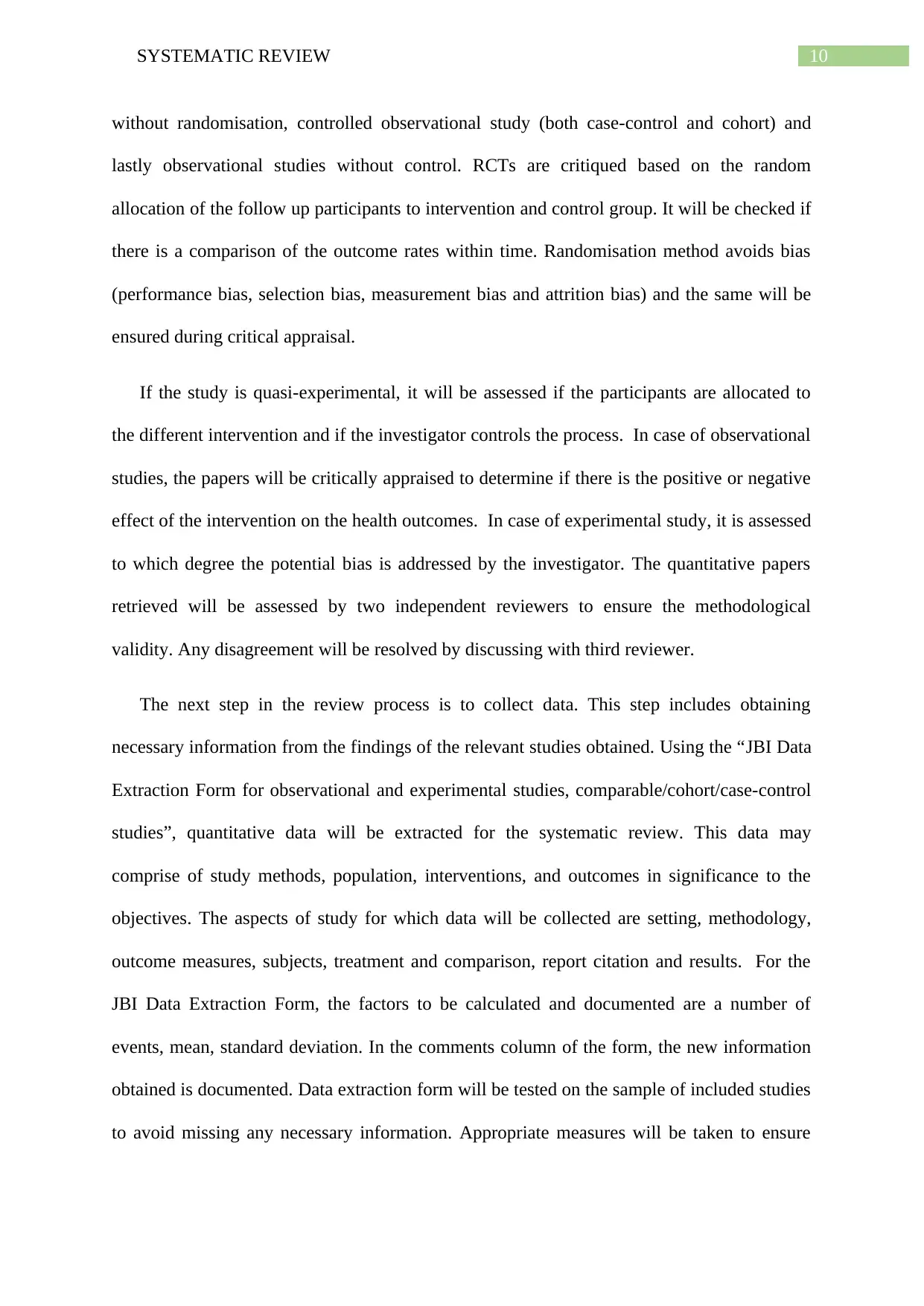
without randomisation, controlled observational study (both case-control and cohort) and
lastly observational studies without control. RCTs are critiqued based on the random
allocation of the follow up participants to intervention and control group. It will be checked if
there is a comparison of the outcome rates within time. Randomisation method avoids bias
(performance bias, selection bias, measurement bias and attrition bias) and the same will be
ensured during critical appraisal.
If the study is quasi-experimental, it will be assessed if the participants are allocated to
the different intervention and if the investigator controls the process. In case of observational
studies, the papers will be critically appraised to determine if there is the positive or negative
effect of the intervention on the health outcomes. In case of experimental study, it is assessed
to which degree the potential bias is addressed by the investigator. The quantitative papers
retrieved will be assessed by two independent reviewers to ensure the methodological
validity. Any disagreement will be resolved by discussing with third reviewer.
The next step in the review process is to collect data. This step includes obtaining
necessary information from the findings of the relevant studies obtained. Using the “JBI Data
Extraction Form for observational and experimental studies, comparable/cohort/case-control
studies”, quantitative data will be extracted for the systematic review. This data may
comprise of study methods, population, interventions, and outcomes in significance to the
objectives. The aspects of study for which data will be collected are setting, methodology,
outcome measures, subjects, treatment and comparison, report citation and results. For the
JBI Data Extraction Form, the factors to be calculated and documented are a number of
events, mean, standard deviation. In the comments column of the form, the new information
obtained is documented. Data extraction form will be tested on the sample of included studies
to avoid missing any necessary information. Appropriate measures will be taken to ensure
Paraphrase This Document
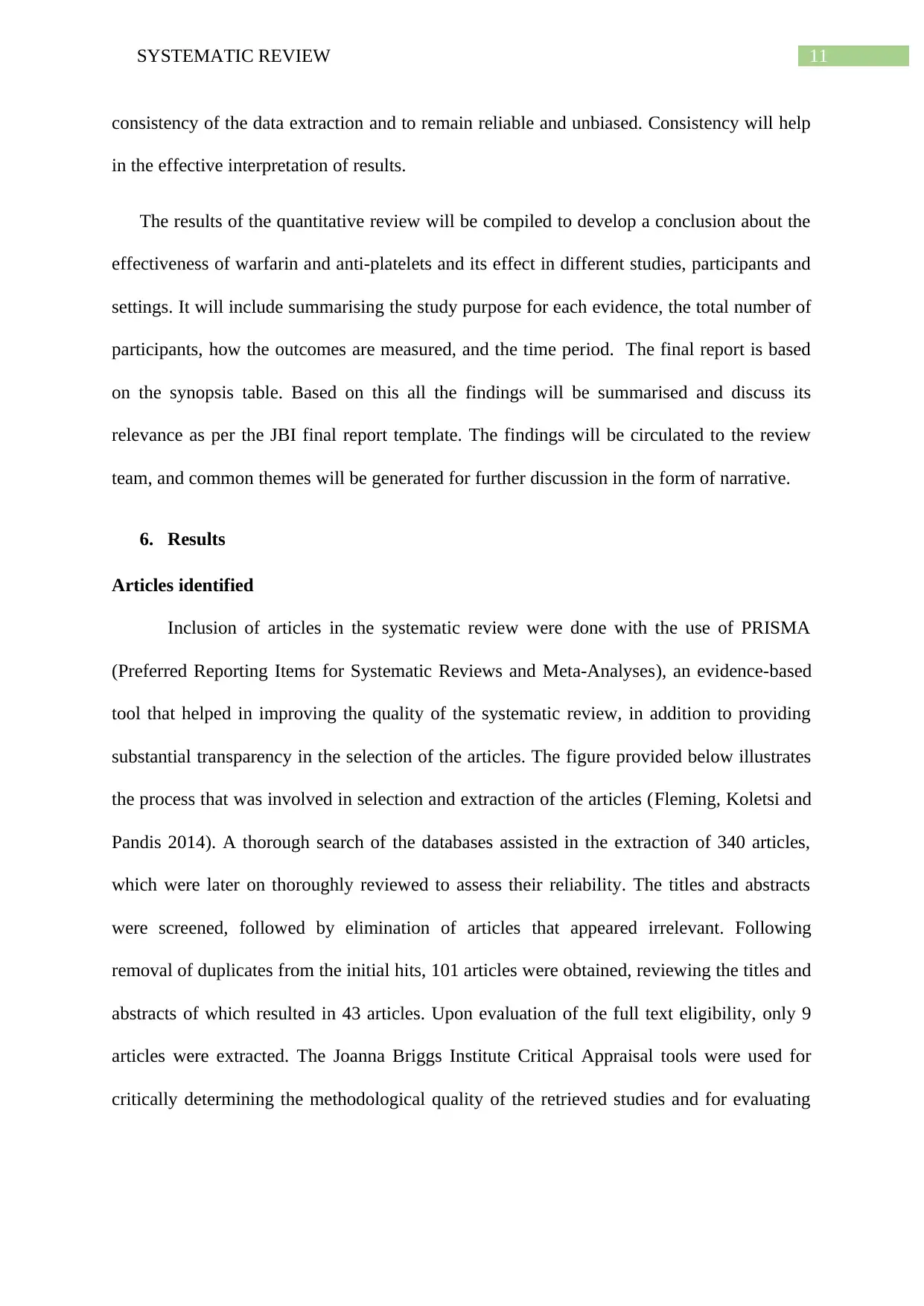
consistency of the data extraction and to remain reliable and unbiased. Consistency will help
in the effective interpretation of results.
The results of the quantitative review will be compiled to develop a conclusion about the
effectiveness of warfarin and anti-platelets and its effect in different studies, participants and
settings. It will include summarising the study purpose for each evidence, the total number of
participants, how the outcomes are measured, and the time period. The final report is based
on the synopsis table. Based on this all the findings will be summarised and discuss its
relevance as per the JBI final report template. The findings will be circulated to the review
team, and common themes will be generated for further discussion in the form of narrative.
6. Results
Articles identified
Inclusion of articles in the systematic review were done with the use of PRISMA
(Preferred Reporting Items for Systematic Reviews and Meta-Analyses), an evidence-based
tool that helped in improving the quality of the systematic review, in addition to providing
substantial transparency in the selection of the articles. The figure provided below illustrates
the process that was involved in selection and extraction of the articles (Fleming, Koletsi and
Pandis 2014). A thorough search of the databases assisted in the extraction of 340 articles,
which were later on thoroughly reviewed to assess their reliability. The titles and abstracts
were screened, followed by elimination of articles that appeared irrelevant. Following
removal of duplicates from the initial hits, 101 articles were obtained, reviewing the titles and
abstracts of which resulted in 43 articles. Upon evaluation of the full text eligibility, only 9
articles were extracted. The Joanna Briggs Institute Critical Appraisal tools were used for
critically determining the methodological quality of the retrieved studies and for evaluating
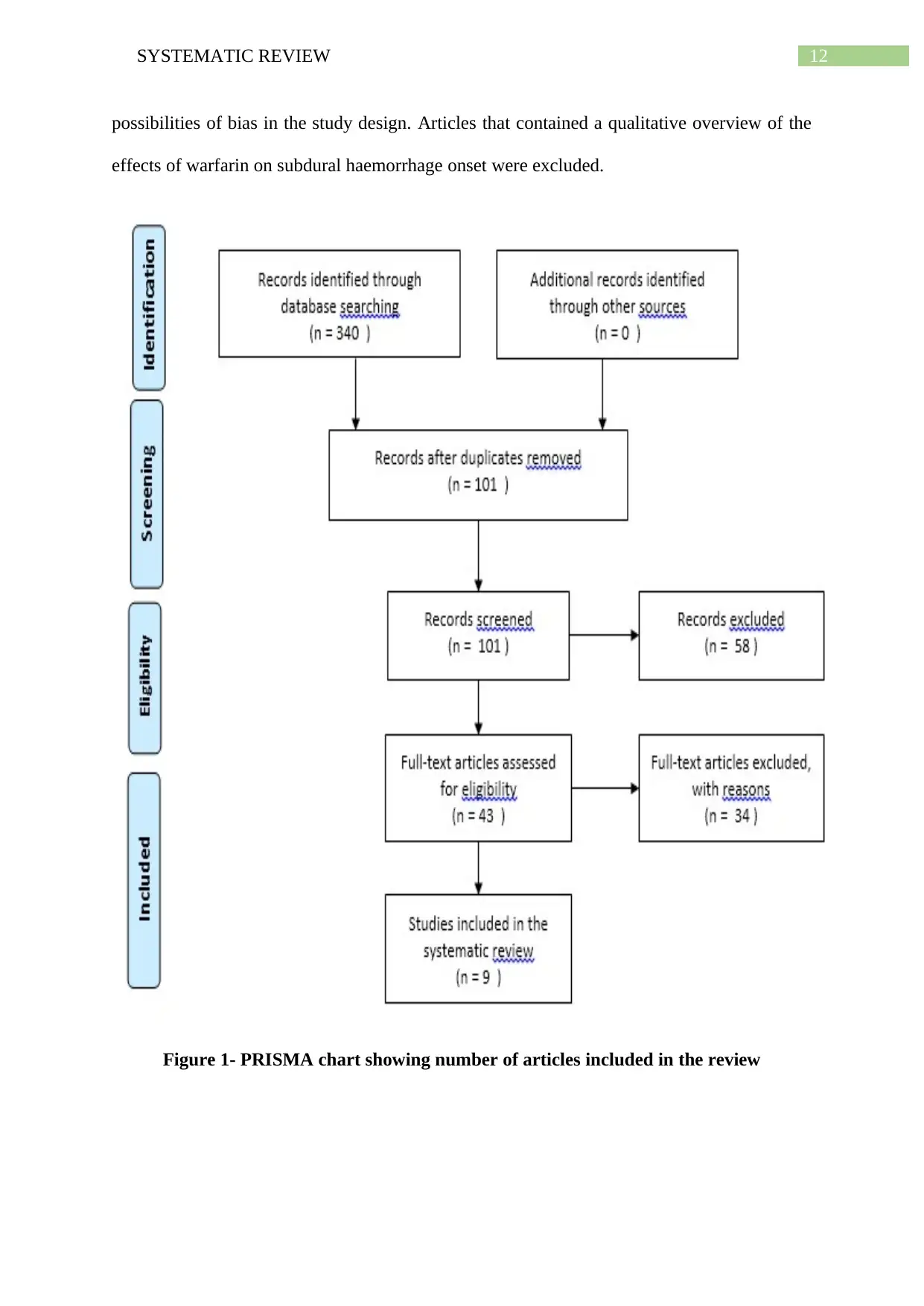
possibilities of bias in the study design. Articles that contained a qualitative overview of the
effects of warfarin on subdural haemorrhage onset were excluded.
Figure 1- PRISMA chart showing number of articles included in the review
⊘ This is a preview!⊘
Do you want full access?
Subscribe today to unlock all pages.

Trusted by 1+ million students worldwide
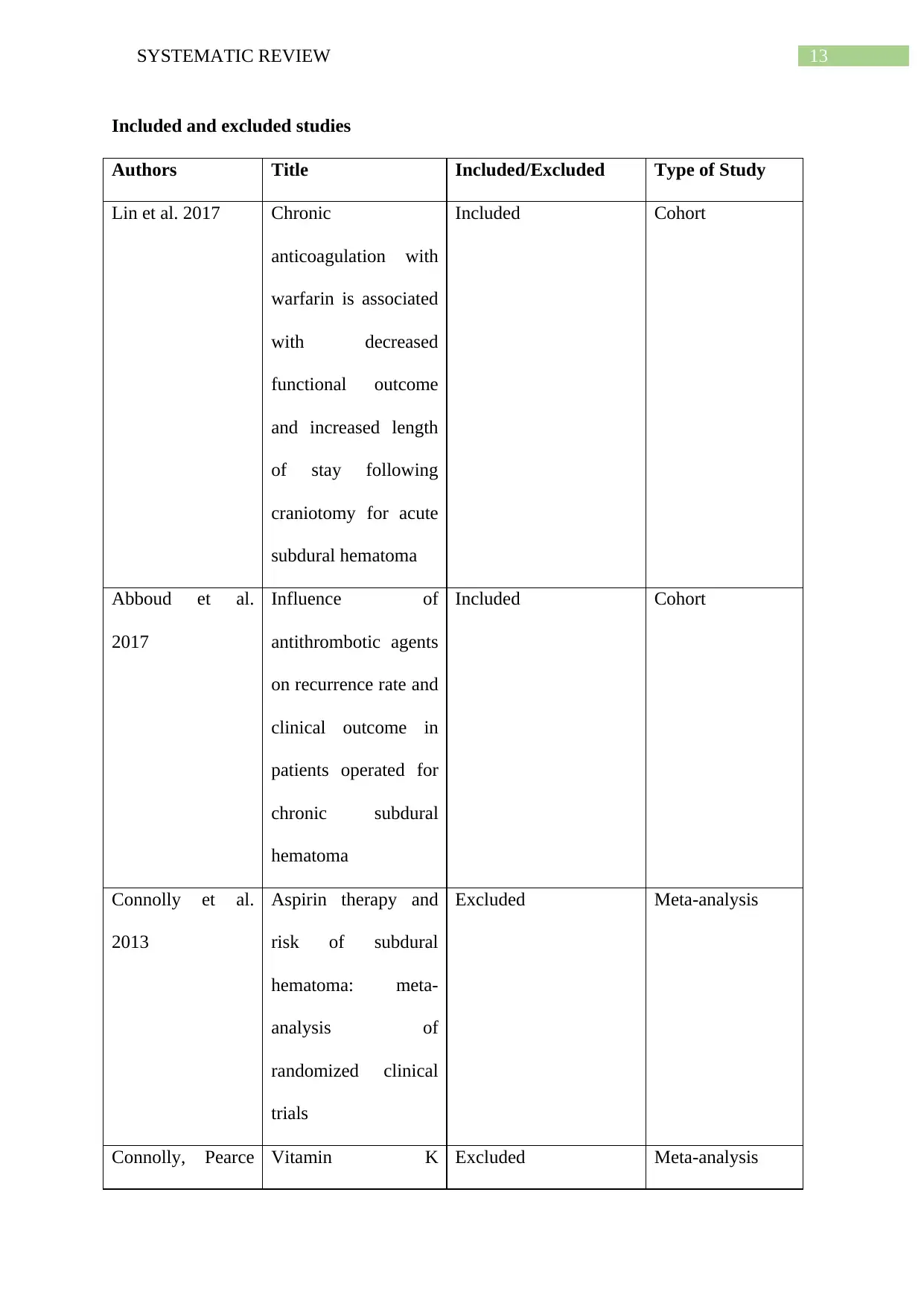
Included and excluded studies
Authors Title Included/Excluded Type of Study
Lin et al. 2017 Chronic
anticoagulation with
warfarin is associated
with decreased
functional outcome
and increased length
of stay following
craniotomy for acute
subdural hematoma
Included Cohort
Abboud et al.
2017
Influence of
antithrombotic agents
on recurrence rate and
clinical outcome in
patients operated for
chronic subdural
hematoma
Included Cohort
Connolly et al.
2013
Aspirin therapy and
risk of subdural
hematoma: meta-
analysis of
randomized clinical
trials
Excluded Meta-analysis
Connolly, Pearce Vitamin K Excluded Meta-analysis
Paraphrase This Document
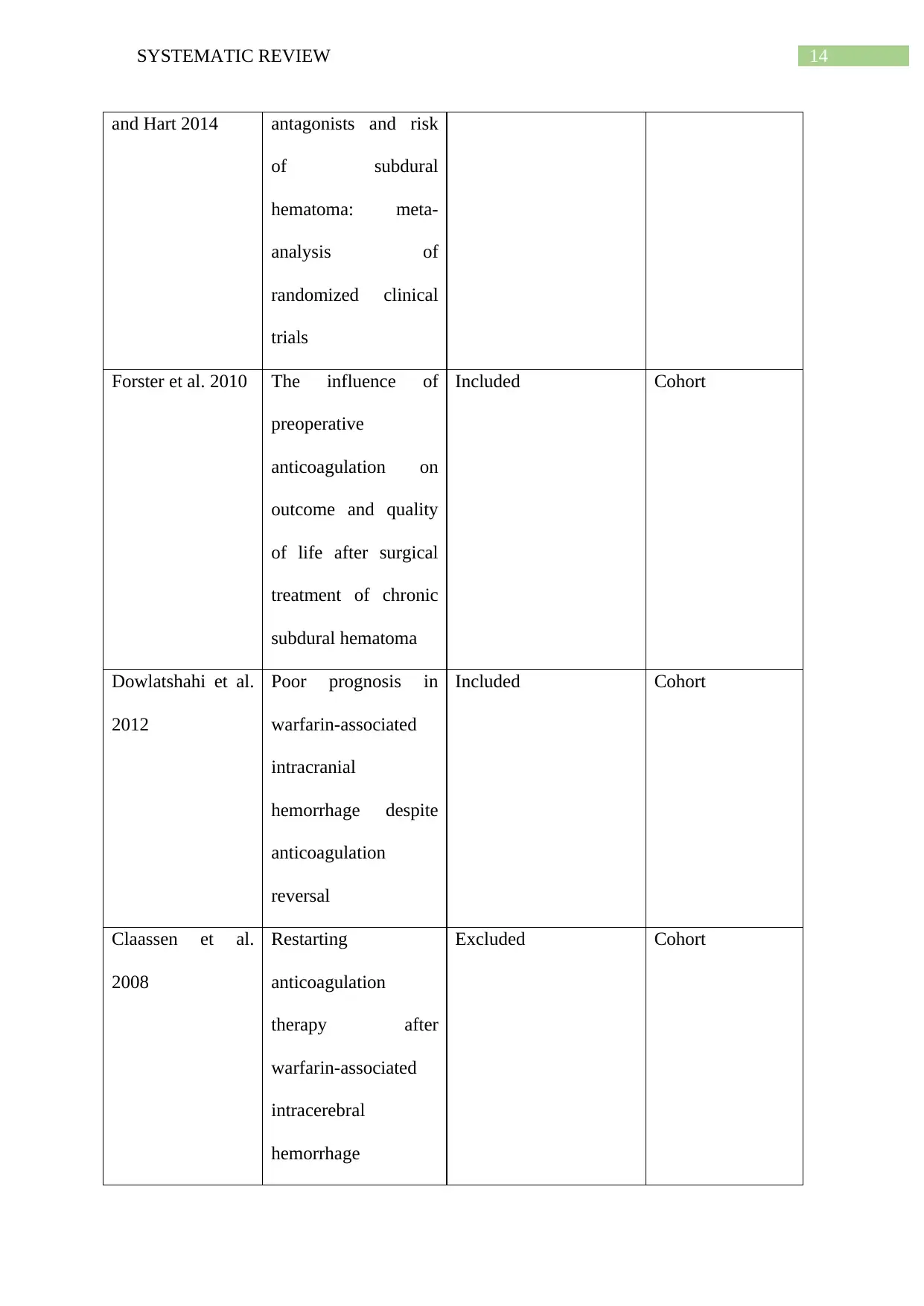
and Hart 2014 antagonists and risk
of subdural
hematoma: meta-
analysis of
randomized clinical
trials
Forster et al. 2010 The influence of
preoperative
anticoagulation on
outcome and quality
of life after surgical
treatment of chronic
subdural hematoma
Included Cohort
Dowlatshahi et al.
2012
Poor prognosis in
warfarin-associated
intracranial
hemorrhage despite
anticoagulation
reversal
Included Cohort
Claassen et al.
2008
Restarting
anticoagulation
therapy after
warfarin-associated
intracerebral
hemorrhage
Excluded Cohort
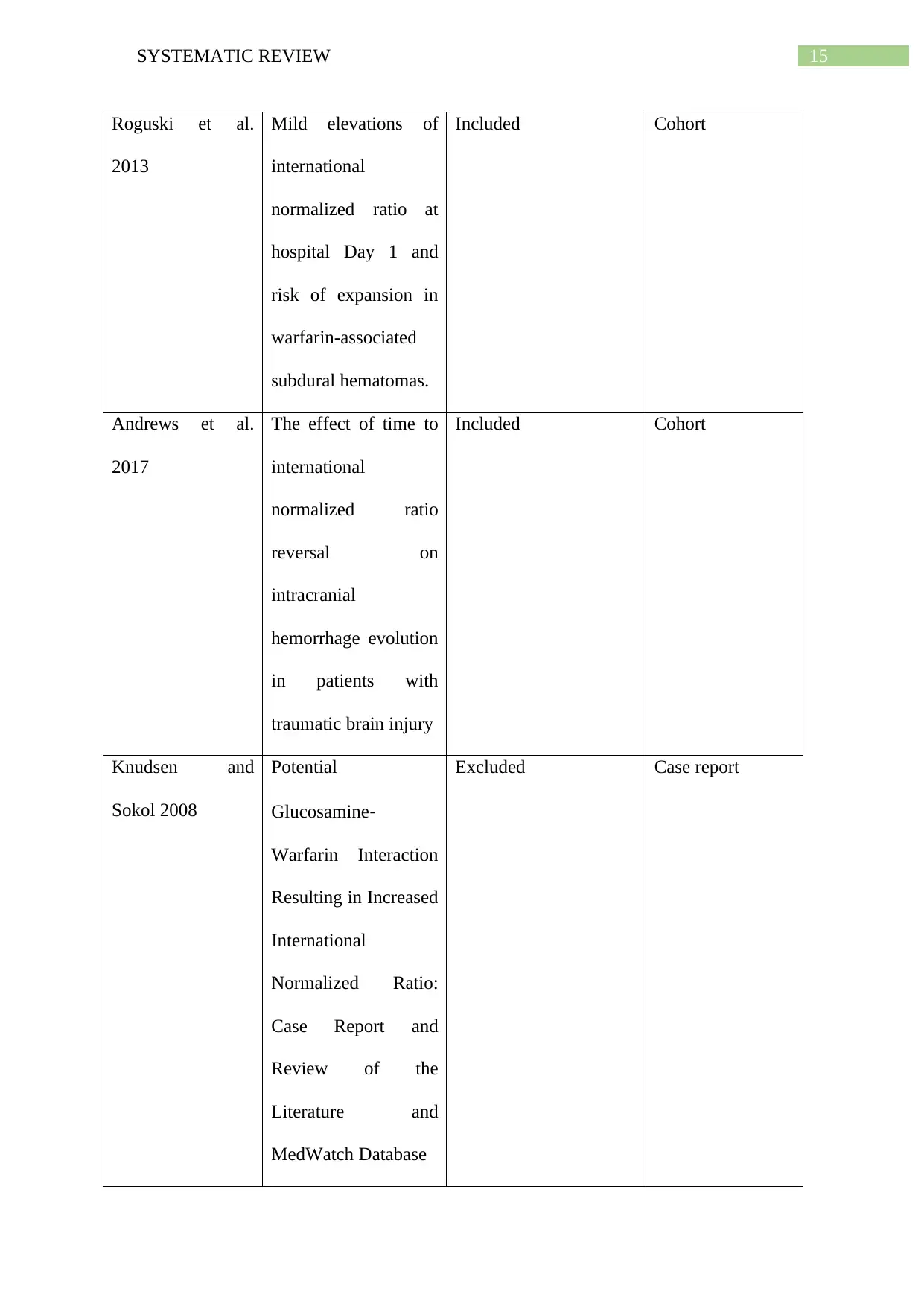
Roguski et al.
2013
Mild elevations of
international
normalized ratio at
hospital Day 1 and
risk of expansion in
warfarin-associated
subdural hematomas.
Included Cohort
Andrews et al.
2017
The effect of time to
international
normalized ratio
reversal on
intracranial
hemorrhage evolution
in patients with
traumatic brain injury
Included Cohort
Knudsen and
Sokol 2008
Potential
Glucosamine‐
Warfarin Interaction
Resulting in Increased
International
Normalized Ratio:
Case Report and
Review of the
Literature and
MedWatch Database
Excluded Case report
⊘ This is a preview!⊘
Do you want full access?
Subscribe today to unlock all pages.

Trusted by 1+ million students worldwide
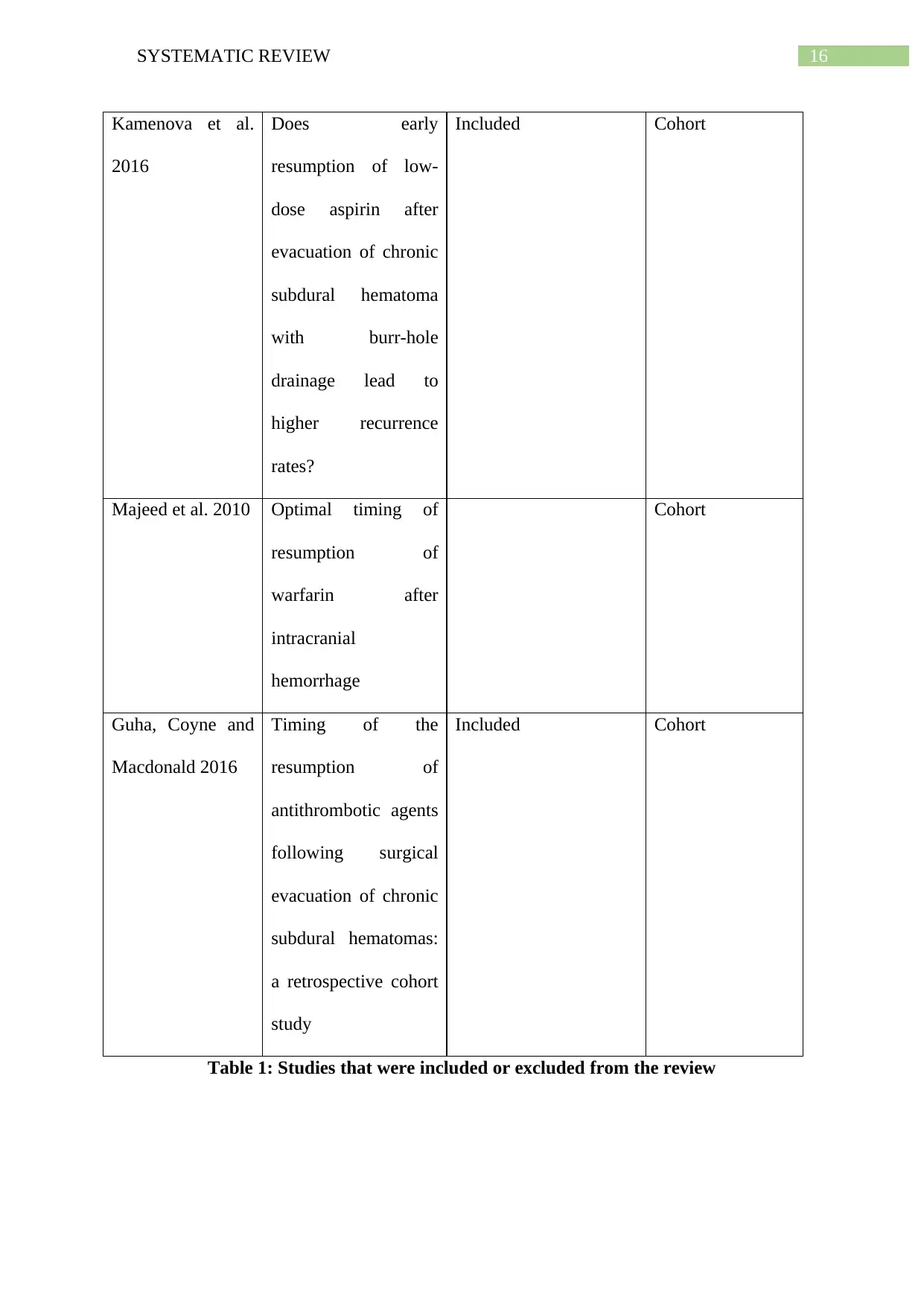
Kamenova et al.
2016
Does early
resumption of low-
dose aspirin after
evacuation of chronic
subdural hematoma
with burr-hole
drainage lead to
higher recurrence
rates?
Included Cohort
Majeed et al. 2010 Optimal timing of
resumption of
warfarin after
intracranial
hemorrhage
Cohort
Guha, Coyne and
Macdonald 2016
Timing of the
resumption of
antithrombotic agents
following surgical
evacuation of chronic
subdural hematomas:
a retrospective cohort
study
Included Cohort
Table 1: Studies that were included or excluded from the review
Paraphrase This Document
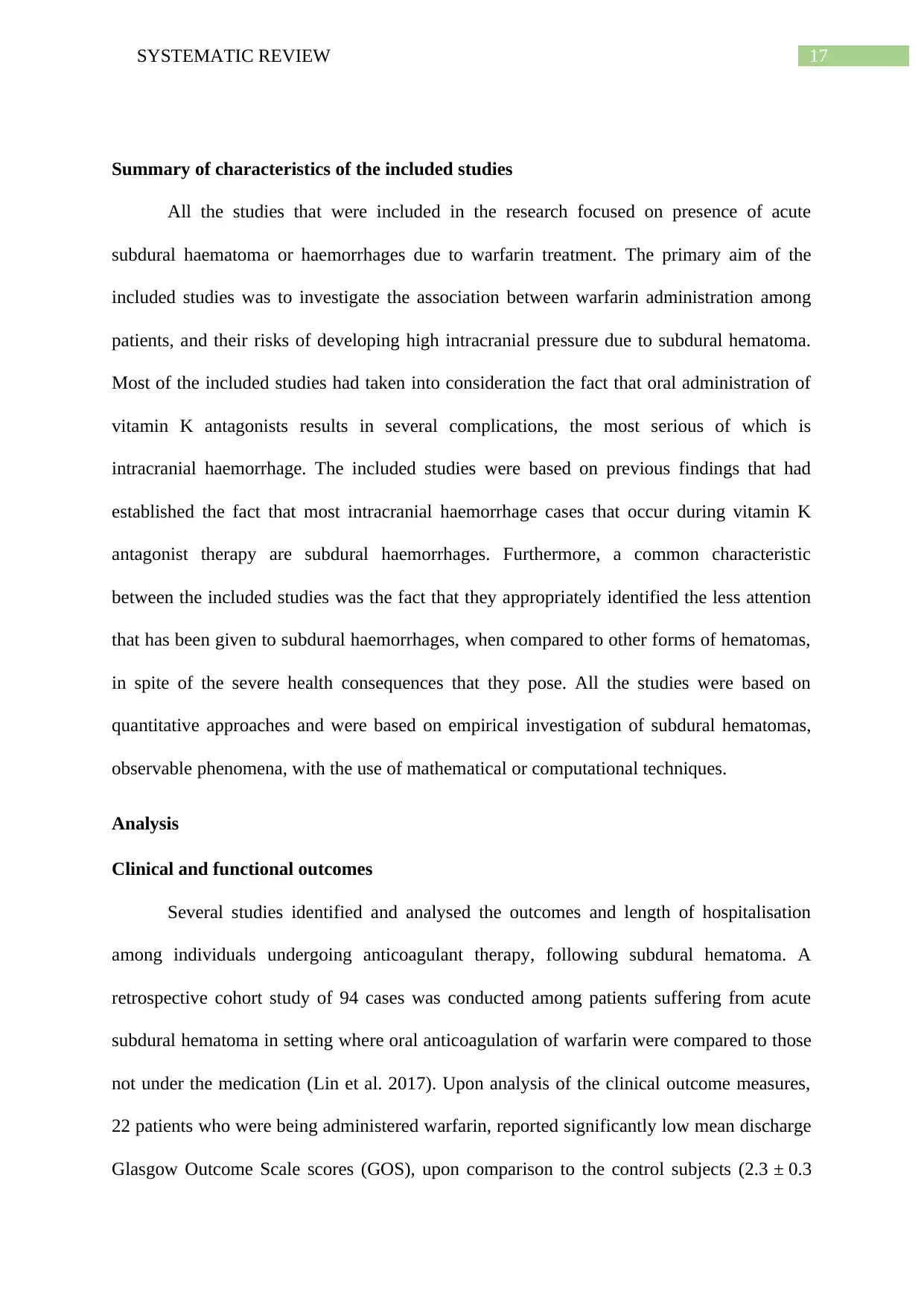
Summary of characteristics of the included studies
All the studies that were included in the research focused on presence of acute
subdural haematoma or haemorrhages due to warfarin treatment. The primary aim of the
included studies was to investigate the association between warfarin administration among
patients, and their risks of developing high intracranial pressure due to subdural hematoma.
Most of the included studies had taken into consideration the fact that oral administration of
vitamin K antagonists results in several complications, the most serious of which is
intracranial haemorrhage. The included studies were based on previous findings that had
established the fact that most intracranial haemorrhage cases that occur during vitamin K
antagonist therapy are subdural haemorrhages. Furthermore, a common characteristic
between the included studies was the fact that they appropriately identified the less attention
that has been given to subdural haemorrhages, when compared to other forms of hematomas,
in spite of the severe health consequences that they pose. All the studies were based on
quantitative approaches and were based on empirical investigation of subdural hematomas,
observable phenomena, with the use of mathematical or computational techniques.
Analysis
Clinical and functional outcomes
Several studies identified and analysed the outcomes and length of hospitalisation
among individuals undergoing anticoagulant therapy, following subdural hematoma. A
retrospective cohort study of 94 cases was conducted among patients suffering from acute
subdural hematoma in setting where oral anticoagulation of warfarin were compared to those
not under the medication (Lin et al. 2017). Upon analysis of the clinical outcome measures,
22 patients who were being administered warfarin, reported significantly low mean discharge
Glasgow Outcome Scale scores (GOS), upon comparison to the control subjects (2.3 ± 0.3
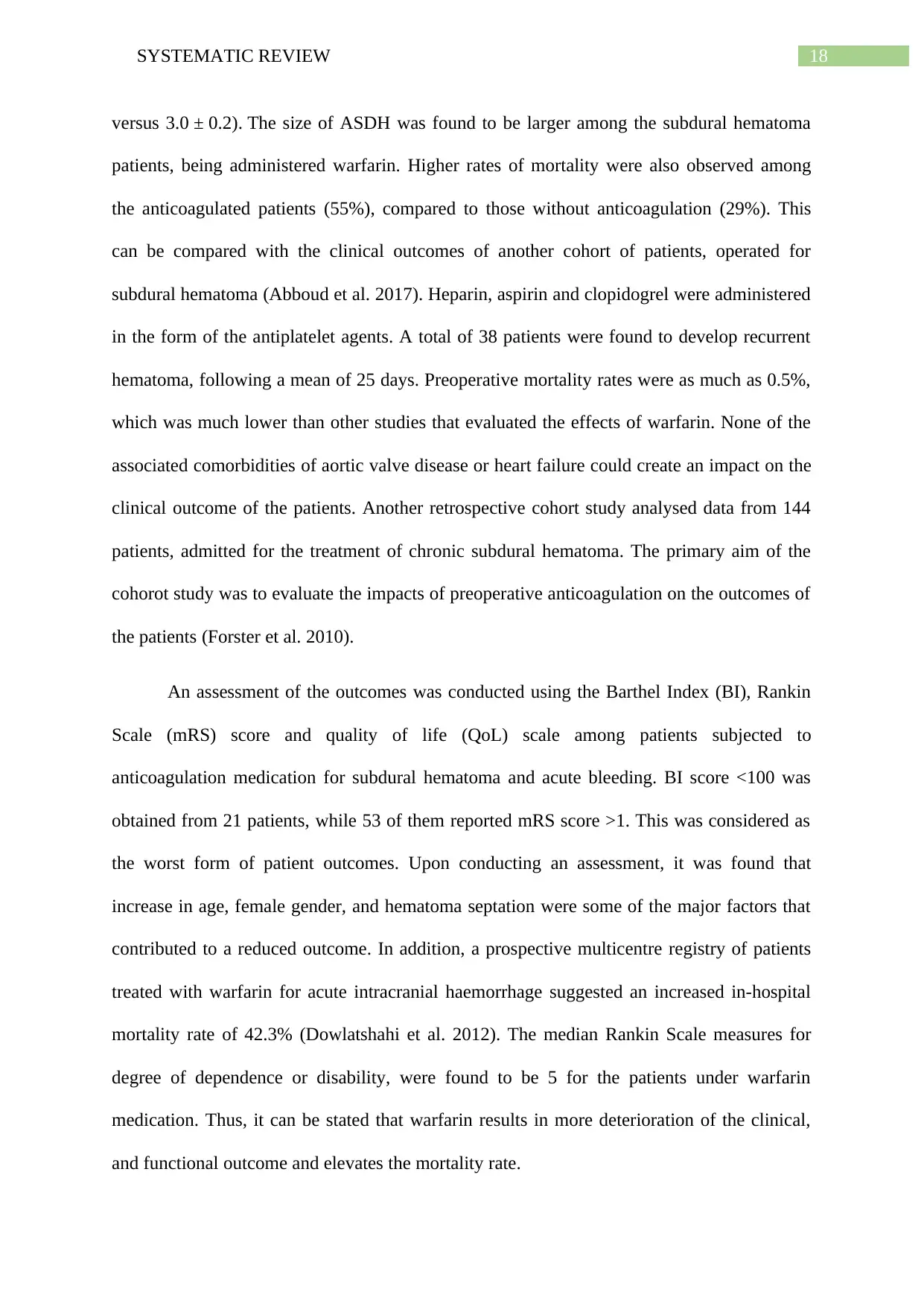
versus 3.0 ± 0.2). The size of ASDH was found to be larger among the subdural hematoma
patients, being administered warfarin. Higher rates of mortality were also observed among
the anticoagulated patients (55%), compared to those without anticoagulation (29%). This
can be compared with the clinical outcomes of another cohort of patients, operated for
subdural hematoma (Abboud et al. 2017). Heparin, aspirin and clopidogrel were administered
in the form of the antiplatelet agents. A total of 38 patients were found to develop recurrent
hematoma, following a mean of 25 days. Preoperative mortality rates were as much as 0.5%,
which was much lower than other studies that evaluated the effects of warfarin. None of the
associated comorbidities of aortic valve disease or heart failure could create an impact on the
clinical outcome of the patients. Another retrospective cohort study analysed data from 144
patients, admitted for the treatment of chronic subdural hematoma. The primary aim of the
cohorot study was to evaluate the impacts of preoperative anticoagulation on the outcomes of
the patients (Forster et al. 2010).
An assessment of the outcomes was conducted using the Barthel Index (BI), Rankin
Scale (mRS) score and quality of life (QoL) scale among patients subjected to
anticoagulation medication for subdural hematoma and acute bleeding. BI score <100 was
obtained from 21 patients, while 53 of them reported mRS score >1. This was considered as
the worst form of patient outcomes. Upon conducting an assessment, it was found that
increase in age, female gender, and hematoma septation were some of the major factors that
contributed to a reduced outcome. In addition, a prospective multicentre registry of patients
treated with warfarin for acute intracranial haemorrhage suggested an increased in-hospital
mortality rate of 42.3% (Dowlatshahi et al. 2012). The median Rankin Scale measures for
degree of dependence or disability, were found to be 5 for the patients under warfarin
medication. Thus, it can be stated that warfarin results in more deterioration of the clinical,
and functional outcome and elevates the mortality rate.
⊘ This is a preview!⊘
Do you want full access?
Subscribe today to unlock all pages.

Trusted by 1+ million students worldwide
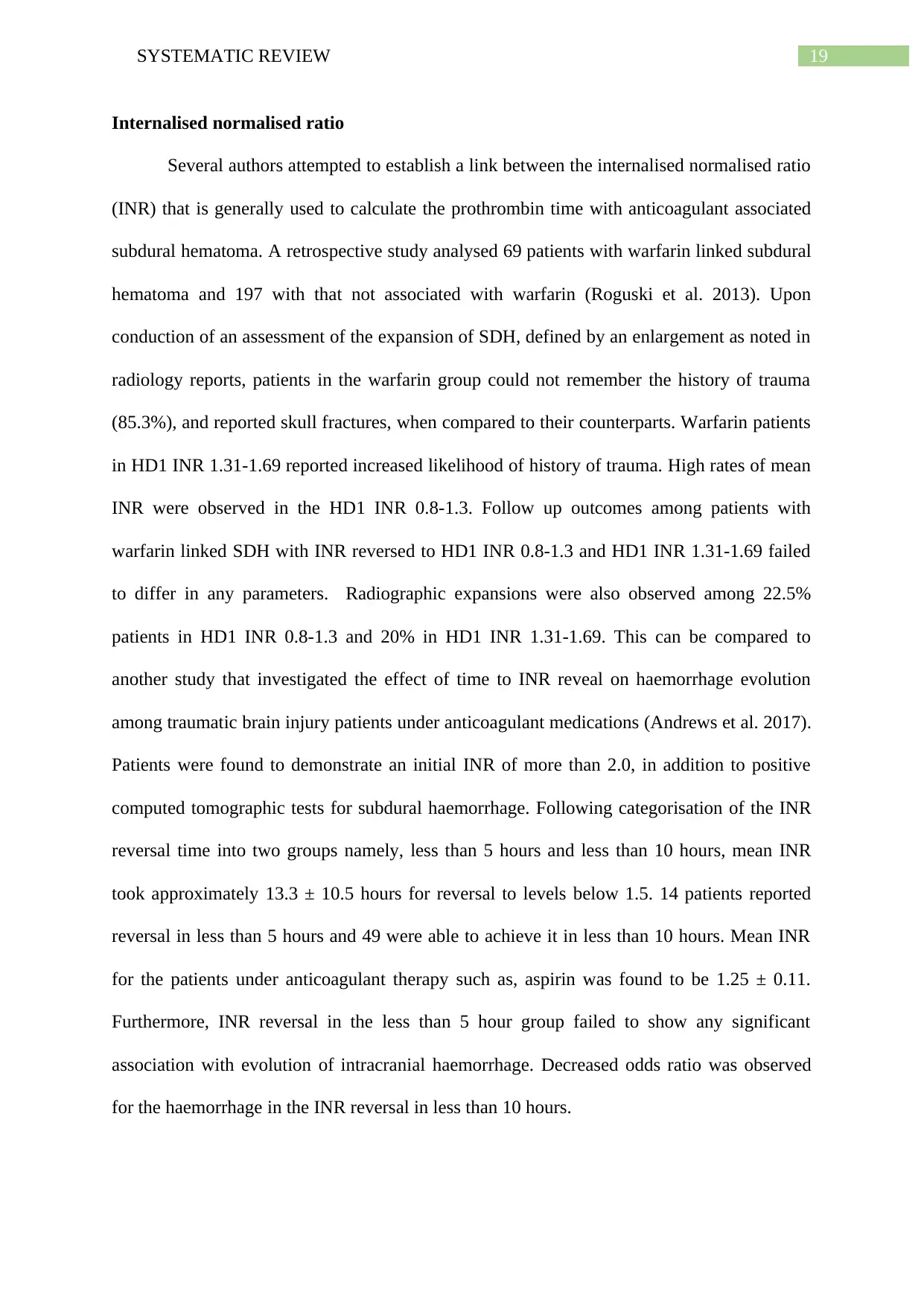
Internalised normalised ratio
Several authors attempted to establish a link between the internalised normalised ratio
(INR) that is generally used to calculate the prothrombin time with anticoagulant associated
subdural hematoma. A retrospective study analysed 69 patients with warfarin linked subdural
hematoma and 197 with that not associated with warfarin (Roguski et al. 2013). Upon
conduction of an assessment of the expansion of SDH, defined by an enlargement as noted in
radiology reports, patients in the warfarin group could not remember the history of trauma
(85.3%), and reported skull fractures, when compared to their counterparts. Warfarin patients
in HD1 INR 1.31-1.69 reported increased likelihood of history of trauma. High rates of mean
INR were observed in the HD1 INR 0.8-1.3. Follow up outcomes among patients with
warfarin linked SDH with INR reversed to HD1 INR 0.8-1.3 and HD1 INR 1.31-1.69 failed
to differ in any parameters. Radiographic expansions were also observed among 22.5%
patients in HD1 INR 0.8-1.3 and 20% in HD1 INR 1.31-1.69. This can be compared to
another study that investigated the effect of time to INR reveal on haemorrhage evolution
among traumatic brain injury patients under anticoagulant medications (Andrews et al. 2017).
Patients were found to demonstrate an initial INR of more than 2.0, in addition to positive
computed tomographic tests for subdural haemorrhage. Following categorisation of the INR
reversal time into two groups namely, less than 5 hours and less than 10 hours, mean INR
took approximately 13.3 ± 10.5 hours for reversal to levels below 1.5. 14 patients reported
reversal in less than 5 hours and 49 were able to achieve it in less than 10 hours. Mean INR
for the patients under anticoagulant therapy such as, aspirin was found to be 1.25 ± 0.11.
Furthermore, INR reversal in the less than 5 hour group failed to show any significant
association with evolution of intracranial haemorrhage. Decreased odds ratio was observed
for the haemorrhage in the INR reversal in less than 10 hours.
Paraphrase This Document
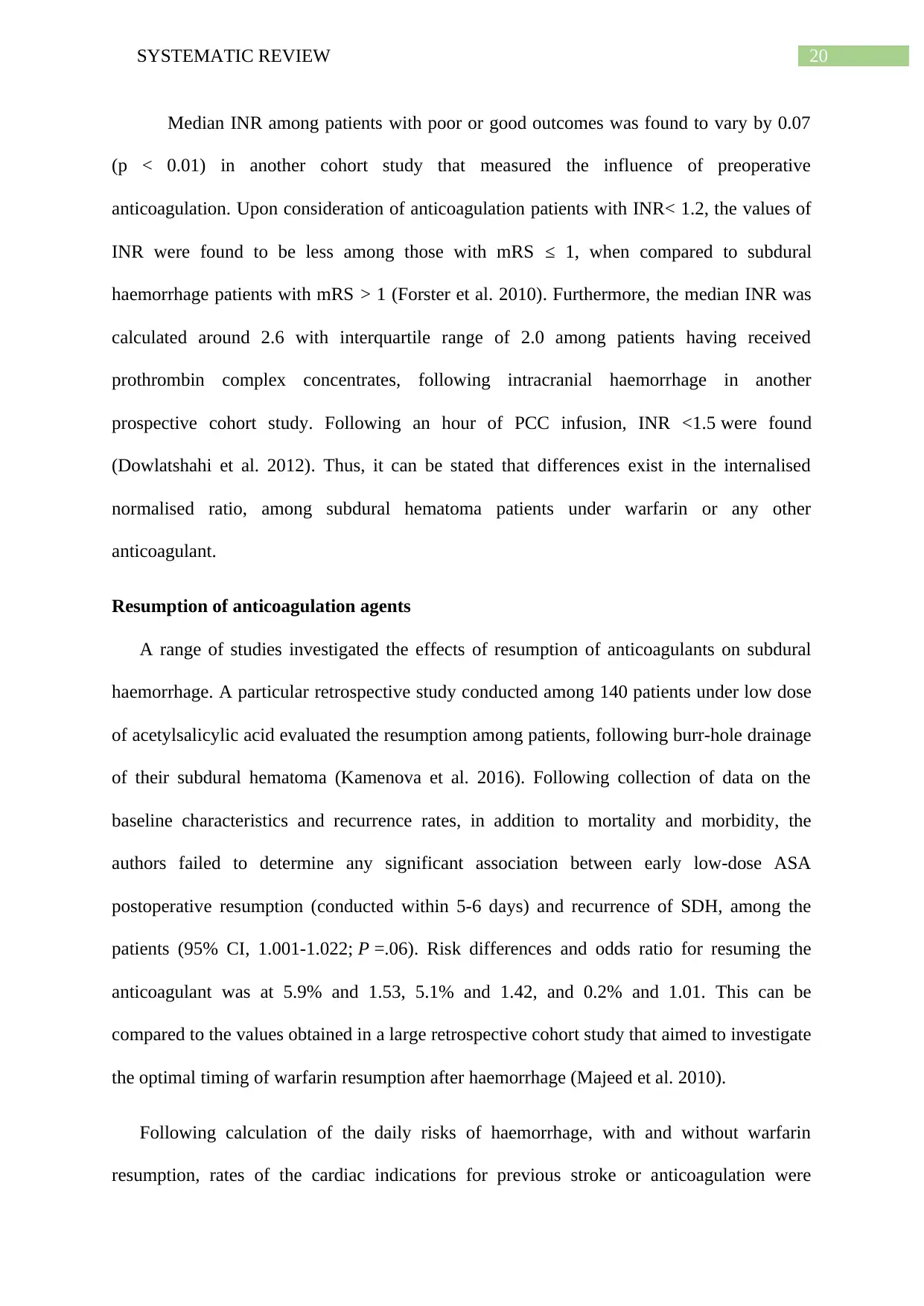
Median INR among patients with poor or good outcomes was found to vary by 0.07
(p < 0.01) in another cohort study that measured the influence of preoperative
anticoagulation. Upon consideration of anticoagulation patients with INR< 1.2, the values of
INR were found to be less among those with mRS ≤ 1, when compared to subdural
haemorrhage patients with mRS > 1 (Forster et al. 2010). Furthermore, the median INR was
calculated around 2.6 with interquartile range of 2.0 among patients having received
prothrombin complex concentrates, following intracranial haemorrhage in another
prospective cohort study. Following an hour of PCC infusion, INR <1.5 were found
(Dowlatshahi et al. 2012). Thus, it can be stated that differences exist in the internalised
normalised ratio, among subdural hematoma patients under warfarin or any other
anticoagulant.
Resumption of anticoagulation agents
A range of studies investigated the effects of resumption of anticoagulants on subdural
haemorrhage. A particular retrospective study conducted among 140 patients under low dose
of acetylsalicylic acid evaluated the resumption among patients, following burr-hole drainage
of their subdural hematoma (Kamenova et al. 2016). Following collection of data on the
baseline characteristics and recurrence rates, in addition to mortality and morbidity, the
authors failed to determine any significant association between early low-dose ASA
postoperative resumption (conducted within 5-6 days) and recurrence of SDH, among the
patients (95% CI, 1.001-1.022; P =.06). Risk differences and odds ratio for resuming the
anticoagulant was at 5.9% and 1.53, 5.1% and 1.42, and 0.2% and 1.01. This can be
compared to the values obtained in a large retrospective cohort study that aimed to investigate
the optimal timing of warfarin resumption after haemorrhage (Majeed et al. 2010).
Following calculation of the daily risks of haemorrhage, with and without warfarin
resumption, rates of the cardiac indications for previous stroke or anticoagulation were
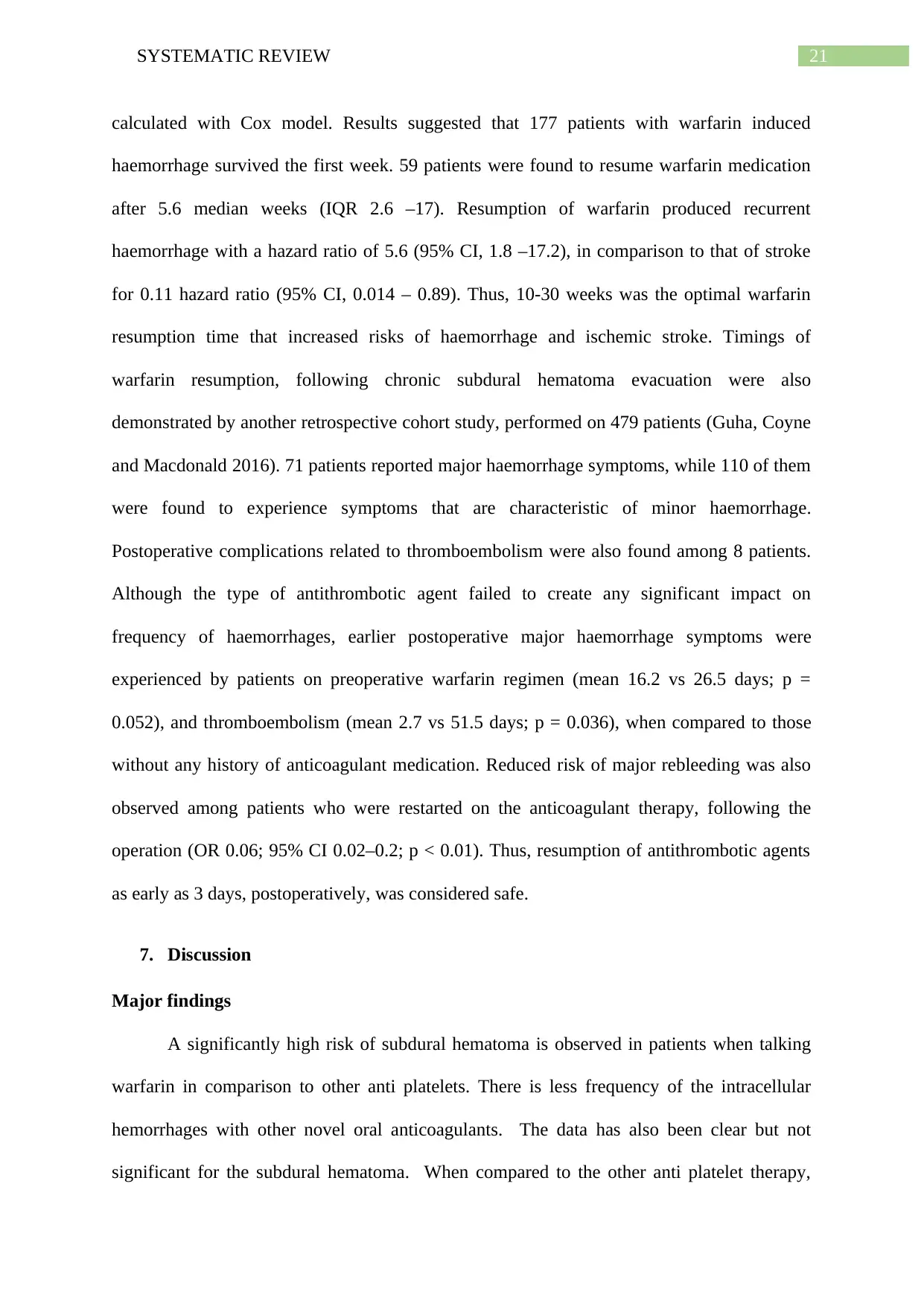
calculated with Cox model. Results suggested that 177 patients with warfarin induced
haemorrhage survived the first week. 59 patients were found to resume warfarin medication
after 5.6 median weeks (IQR 2.6 –17). Resumption of warfarin produced recurrent
haemorrhage with a hazard ratio of 5.6 (95% CI, 1.8 –17.2), in comparison to that of stroke
for 0.11 hazard ratio (95% CI, 0.014 – 0.89). Thus, 10-30 weeks was the optimal warfarin
resumption time that increased risks of haemorrhage and ischemic stroke. Timings of
warfarin resumption, following chronic subdural hematoma evacuation were also
demonstrated by another retrospective cohort study, performed on 479 patients (Guha, Coyne
and Macdonald 2016). 71 patients reported major haemorrhage symptoms, while 110 of them
were found to experience symptoms that are characteristic of minor haemorrhage.
Postoperative complications related to thromboembolism were also found among 8 patients.
Although the type of antithrombotic agent failed to create any significant impact on
frequency of haemorrhages, earlier postoperative major haemorrhage symptoms were
experienced by patients on preoperative warfarin regimen (mean 16.2 vs 26.5 days; p =
0.052), and thromboembolism (mean 2.7 vs 51.5 days; p = 0.036), when compared to those
without any history of anticoagulant medication. Reduced risk of major rebleeding was also
observed among patients who were restarted on the anticoagulant therapy, following the
operation (OR 0.06; 95% CI 0.02–0.2; p < 0.01). Thus, resumption of antithrombotic agents
as early as 3 days, postoperatively, was considered safe.
7. Discussion
Major findings
A significantly high risk of subdural hematoma is observed in patients when talking
warfarin in comparison to other anti platelets. There is less frequency of the intracellular
hemorrhages with other novel oral anticoagulants. The data has also been clear but not
significant for the subdural hematoma. When compared to the other anti platelet therapy,
⊘ This is a preview!⊘
Do you want full access?
Subscribe today to unlock all pages.

Trusted by 1+ million students worldwide
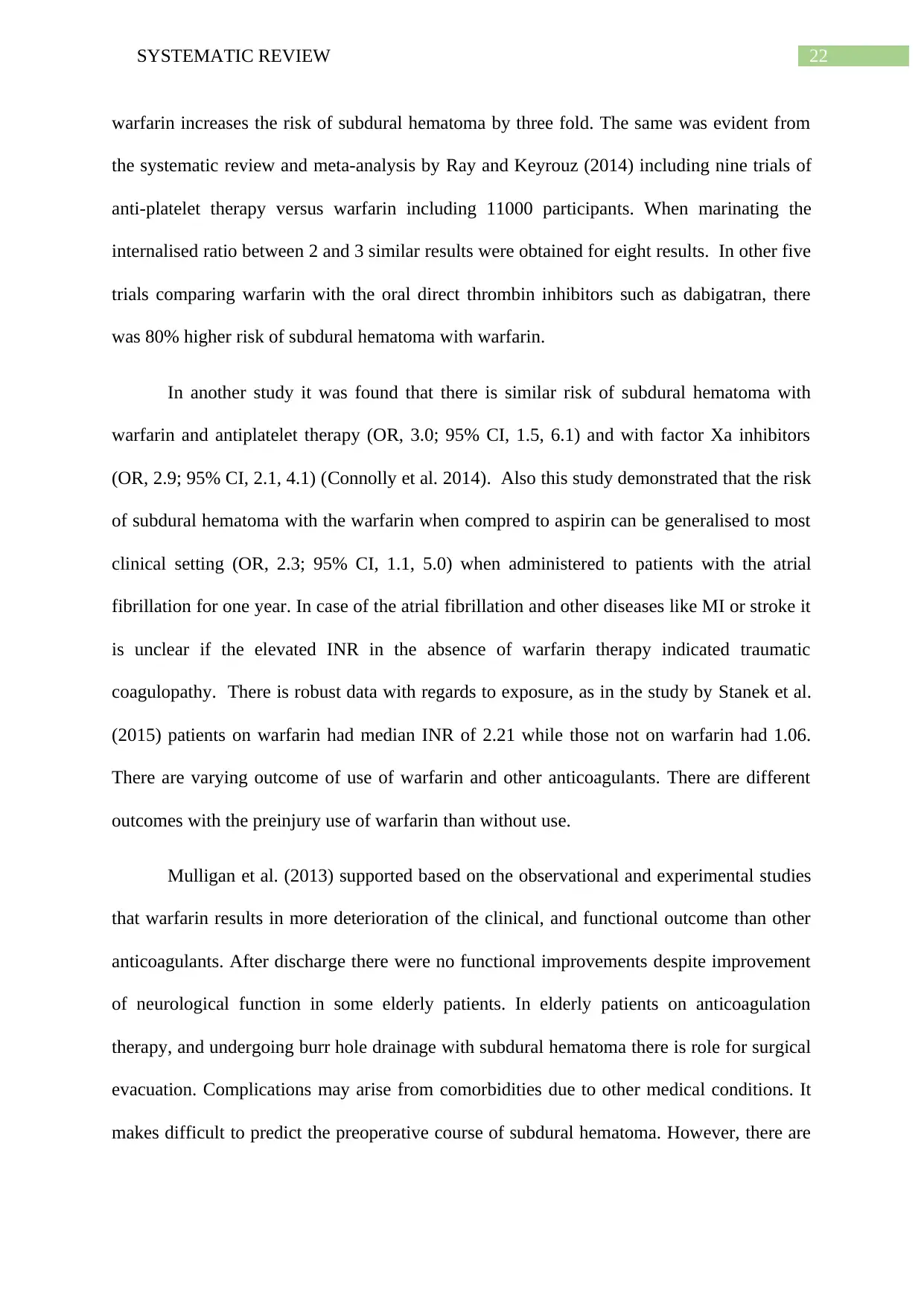
warfarin increases the risk of subdural hematoma by three fold. The same was evident from
the systematic review and meta-analysis by Ray and Keyrouz (2014) including nine trials of
anti-platelet therapy versus warfarin including 11000 participants. When marinating the
internalised ratio between 2 and 3 similar results were obtained for eight results. In other five
trials comparing warfarin with the oral direct thrombin inhibitors such as dabigatran, there
was 80% higher risk of subdural hematoma with warfarin.
In another study it was found that there is similar risk of subdural hematoma with
warfarin and antiplatelet therapy (OR, 3.0; 95% CI, 1.5, 6.1) and with factor Xa inhibitors
(OR, 2.9; 95% CI, 2.1, 4.1) (Connolly et al. 2014). Also this study demonstrated that the risk
of subdural hematoma with the warfarin when compred to aspirin can be generalised to most
clinical setting (OR, 2.3; 95% CI, 1.1, 5.0) when administered to patients with the atrial
fibrillation for one year. In case of the atrial fibrillation and other diseases like MI or stroke it
is unclear if the elevated INR in the absence of warfarin therapy indicated traumatic
coagulopathy. There is robust data with regards to exposure, as in the study by Stanek et al.
(2015) patients on warfarin had median INR of 2.21 while those not on warfarin had 1.06.
There are varying outcome of use of warfarin and other anticoagulants. There are different
outcomes with the preinjury use of warfarin than without use.
Mulligan et al. (2013) supported based on the observational and experimental studies
that warfarin results in more deterioration of the clinical, and functional outcome than other
anticoagulants. After discharge there were no functional improvements despite improvement
of neurological function in some elderly patients. In elderly patients on anticoagulation
therapy, and undergoing burr hole drainage with subdural hematoma there is role for surgical
evacuation. Complications may arise from comorbidities due to other medical conditions. It
makes difficult to predict the preoperative course of subdural hematoma. However, there are
Paraphrase This Document
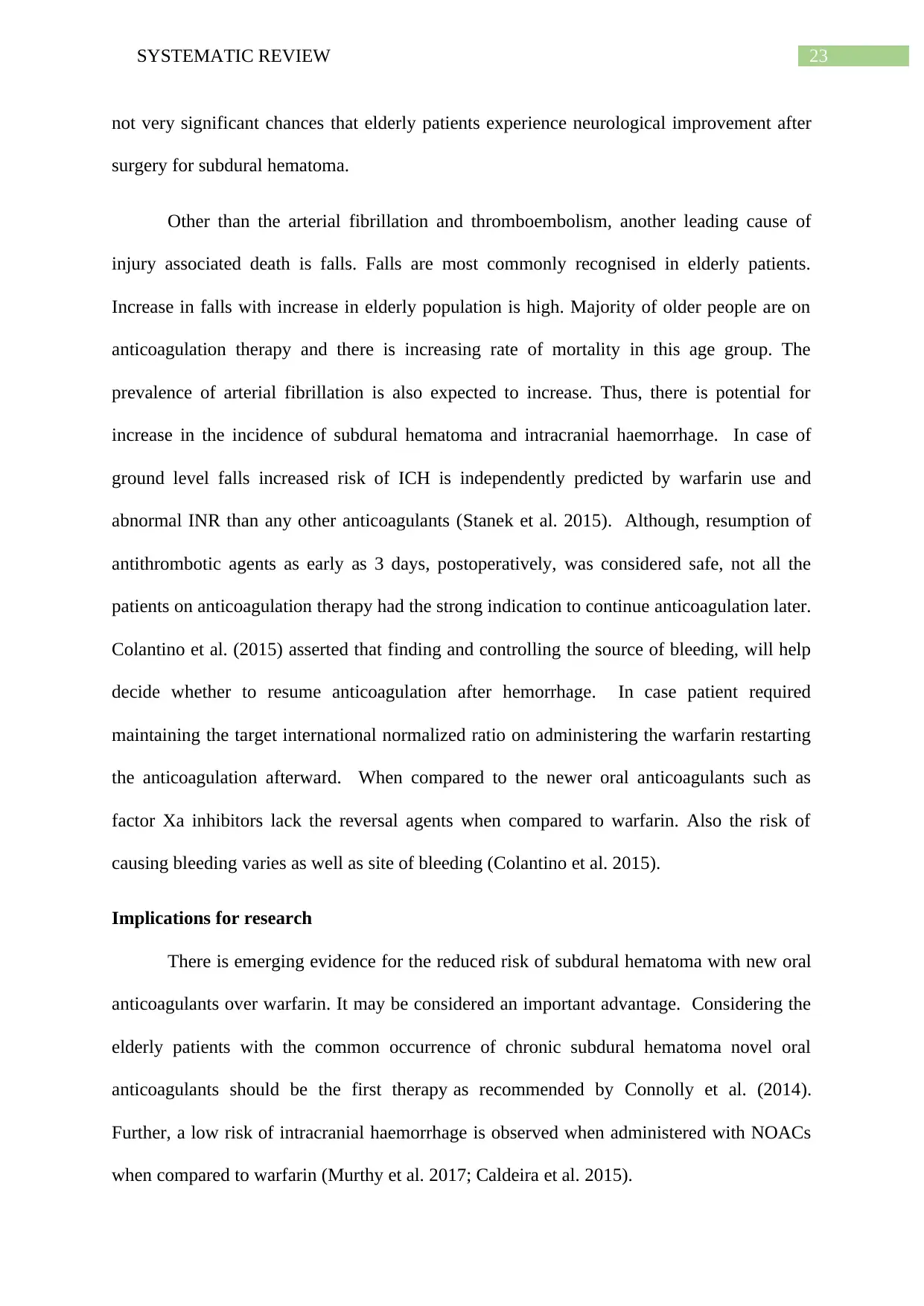
not very significant chances that elderly patients experience neurological improvement after
surgery for subdural hematoma.
Other than the arterial fibrillation and thromboembolism, another leading cause of
injury associated death is falls. Falls are most commonly recognised in elderly patients.
Increase in falls with increase in elderly population is high. Majority of older people are on
anticoagulation therapy and there is increasing rate of mortality in this age group. The
prevalence of arterial fibrillation is also expected to increase. Thus, there is potential for
increase in the incidence of subdural hematoma and intracranial haemorrhage. In case of
ground level falls increased risk of ICH is independently predicted by warfarin use and
abnormal INR than any other anticoagulants (Stanek et al. 2015). Although, resumption of
antithrombotic agents as early as 3 days, postoperatively, was considered safe, not all the
patients on anticoagulation therapy had the strong indication to continue anticoagulation later.
Colantino et al. (2015) asserted that finding and controlling the source of bleeding, will help
decide whether to resume anticoagulation after hemorrhage. In case patient required
maintaining the target international normalized ratio on administering the warfarin restarting
the anticoagulation afterward. When compared to the newer oral anticoagulants such as
factor Xa inhibitors lack the reversal agents when compared to warfarin. Also the risk of
causing bleeding varies as well as site of bleeding (Colantino et al. 2015).
Implications for research
There is emerging evidence for the reduced risk of subdural hematoma with new oral
anticoagulants over warfarin. It may be considered an important advantage. Considering the
elderly patients with the common occurrence of chronic subdural hematoma novel oral
anticoagulants should be the first therapy as recommended by Connolly et al. (2014).
Further, a low risk of intracranial haemorrhage is observed when administered with NOACs
when compared to warfarin (Murthy et al. 2017; Caldeira et al. 2015).
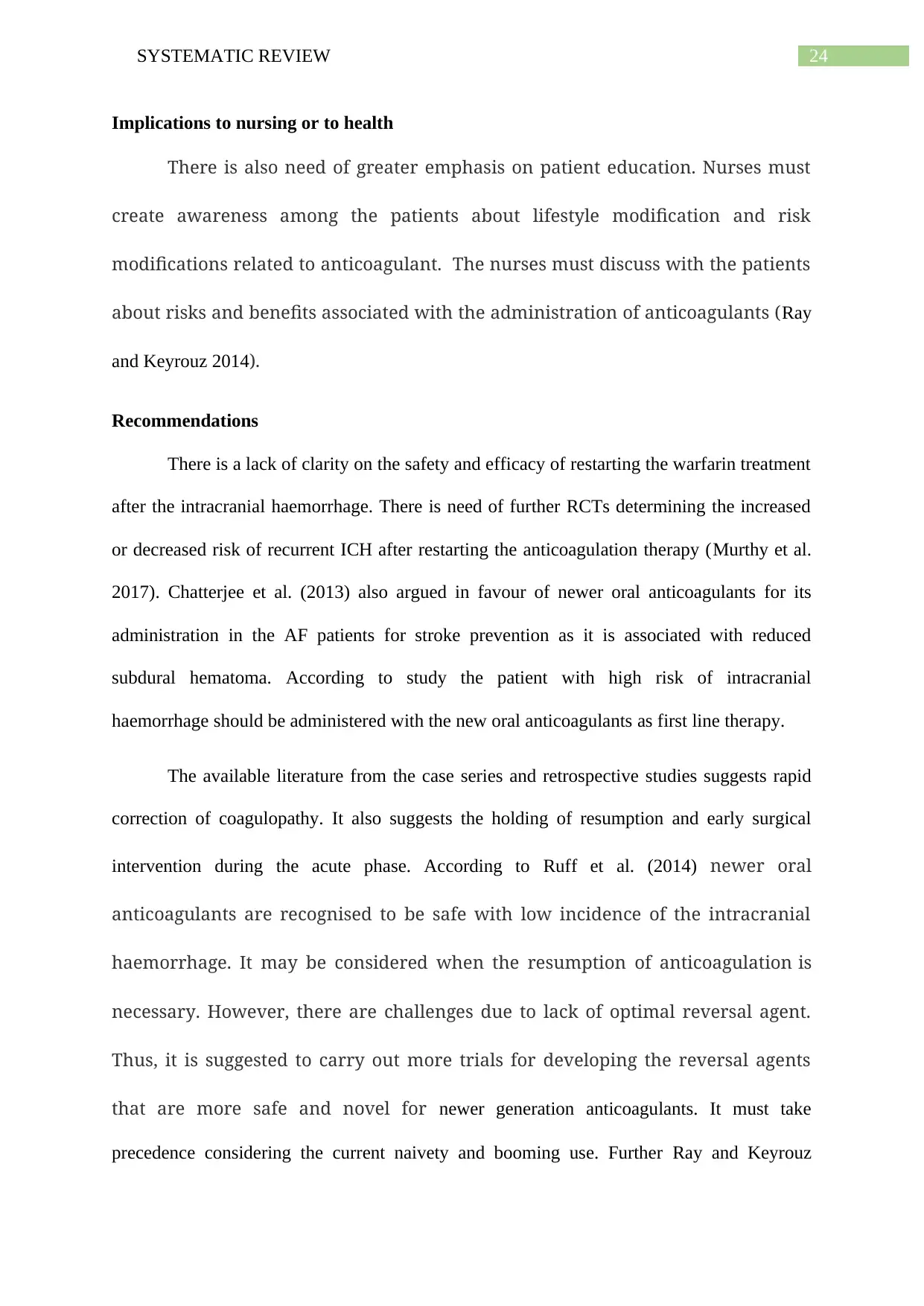
Implications to nursing or to health
There is also need of greater emphasis on patient education. Nurses must
create awareness among the patients about lifestyle modification and risk
modifications related to anticoagulant. The nurses must discuss with the patients
about risks and benefits associated with the administration of anticoagulants (Ray
and Keyrouz 2014).
Recommendations
There is a lack of clarity on the safety and efficacy of restarting the warfarin treatment
after the intracranial haemorrhage. There is need of further RCTs determining the increased
or decreased risk of recurrent ICH after restarting the anticoagulation therapy (Murthy et al.
2017). Chatterjee et al. (2013) also argued in favour of newer oral anticoagulants for its
administration in the AF patients for stroke prevention as it is associated with reduced
subdural hematoma. According to study the patient with high risk of intracranial
haemorrhage should be administered with the new oral anticoagulants as first line therapy.
The available literature from the case series and retrospective studies suggests rapid
correction of coagulopathy. It also suggests the holding of resumption and early surgical
intervention during the acute phase. According to Ruff et al. (2014) newer oral
anticoagulants are recognised to be safe with low incidence of the intracranial
haemorrhage. It may be considered when the resumption of anticoagulation is
necessary. However, there are challenges due to lack of optimal reversal agent.
Thus, it is suggested to carry out more trials for developing the reversal agents
that are more safe and novel for newer generation anticoagulants. It must take
precedence considering the current naivety and booming use. Further Ray and Keyrouz
⊘ This is a preview!⊘
Do you want full access?
Subscribe today to unlock all pages.

Trusted by 1+ million students worldwide
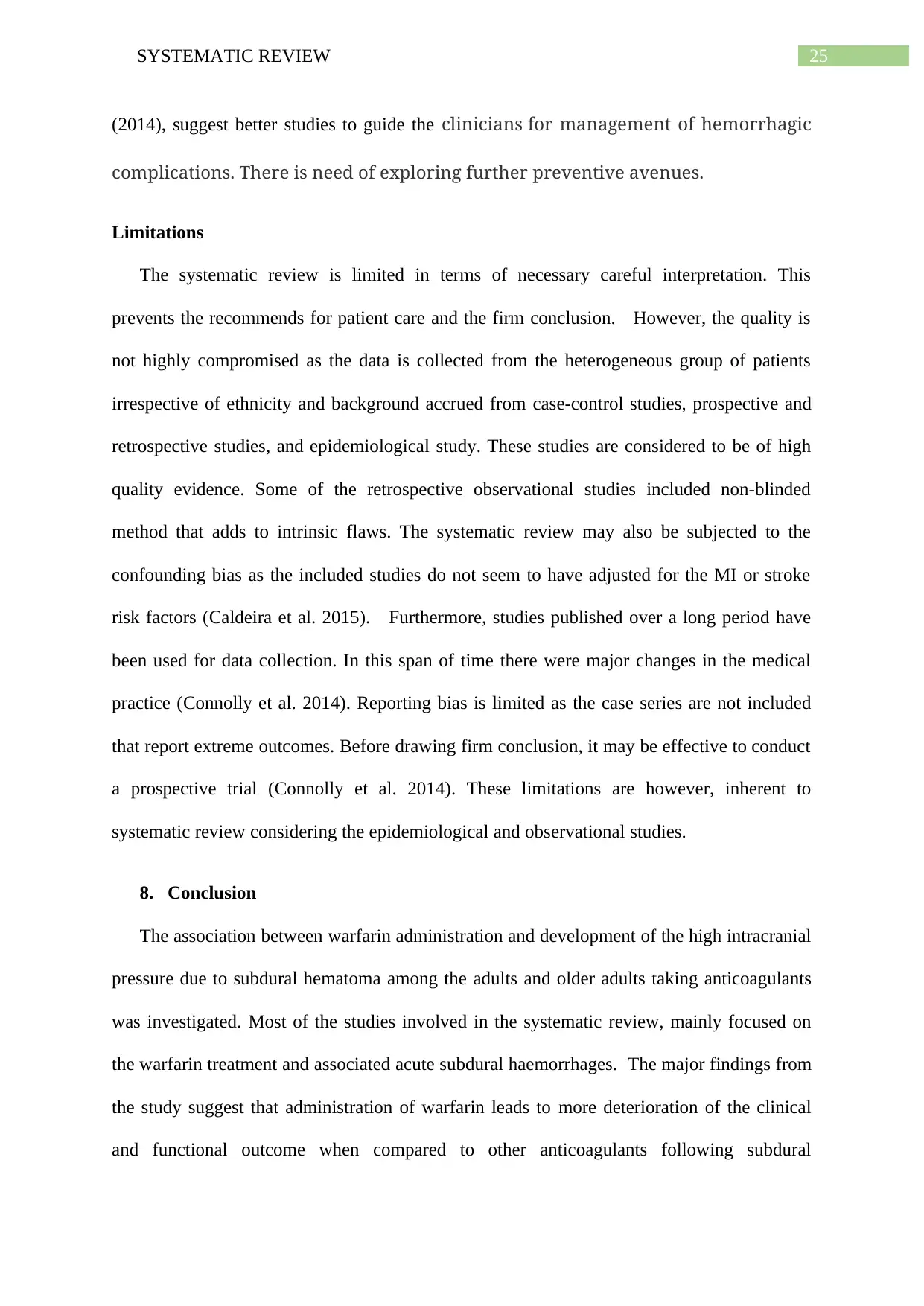
(2014), suggest better studies to guide the clinicians for management of hemorrhagic
complications. There is need of exploring further preventive avenues.
Limitations
The systematic review is limited in terms of necessary careful interpretation. This
prevents the recommends for patient care and the firm conclusion. However, the quality is
not highly compromised as the data is collected from the heterogeneous group of patients
irrespective of ethnicity and background accrued from case-control studies, prospective and
retrospective studies, and epidemiological study. These studies are considered to be of high
quality evidence. Some of the retrospective observational studies included non-blinded
method that adds to intrinsic flaws. The systematic review may also be subjected to the
confounding bias as the included studies do not seem to have adjusted for the MI or stroke
risk factors (Caldeira et al. 2015). Furthermore, studies published over a long period have
been used for data collection. In this span of time there were major changes in the medical
practice (Connolly et al. 2014). Reporting bias is limited as the case series are not included
that report extreme outcomes. Before drawing firm conclusion, it may be effective to conduct
a prospective trial (Connolly et al. 2014). These limitations are however, inherent to
systematic review considering the epidemiological and observational studies.
8. Conclusion
The association between warfarin administration and development of the high intracranial
pressure due to subdural hematoma among the adults and older adults taking anticoagulants
was investigated. Most of the studies involved in the systematic review, mainly focused on
the warfarin treatment and associated acute subdural haemorrhages. The major findings from
the study suggest that administration of warfarin leads to more deterioration of the clinical
and functional outcome when compared to other anticoagulants following subdural
Paraphrase This Document
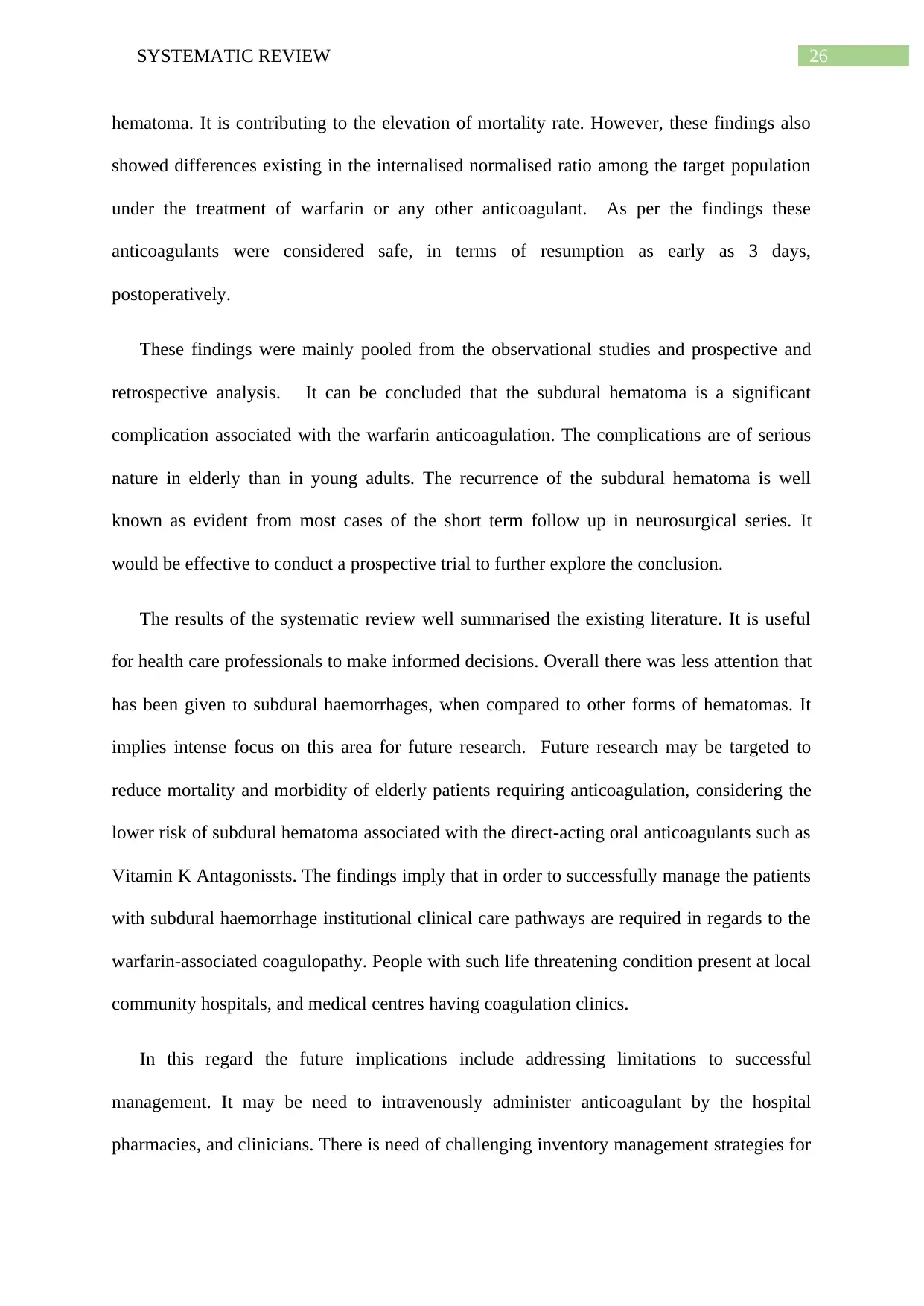
hematoma. It is contributing to the elevation of mortality rate. However, these findings also
showed differences existing in the internalised normalised ratio among the target population
under the treatment of warfarin or any other anticoagulant. As per the findings these
anticoagulants were considered safe, in terms of resumption as early as 3 days,
postoperatively.
These findings were mainly pooled from the observational studies and prospective and
retrospective analysis. It can be concluded that the subdural hematoma is a significant
complication associated with the warfarin anticoagulation. The complications are of serious
nature in elderly than in young adults. The recurrence of the subdural hematoma is well
known as evident from most cases of the short term follow up in neurosurgical series. It
would be effective to conduct a prospective trial to further explore the conclusion.
The results of the systematic review well summarised the existing literature. It is useful
for health care professionals to make informed decisions. Overall there was less attention that
has been given to subdural haemorrhages, when compared to other forms of hematomas. It
implies intense focus on this area for future research. Future research may be targeted to
reduce mortality and morbidity of elderly patients requiring anticoagulation, considering the
lower risk of subdural hematoma associated with the direct-acting oral anticoagulants such as
Vitamin K Antagonissts. The findings imply that in order to successfully manage the patients
with subdural haemorrhage institutional clinical care pathways are required in regards to the
warfarin-associated coagulopathy. People with such life threatening condition present at local
community hospitals, and medical centres having coagulation clinics.
In this regard the future implications include addressing limitations to successful
management. It may be need to intravenously administer anticoagulant by the hospital
pharmacies, and clinicians. There is need of challenging inventory management strategies for
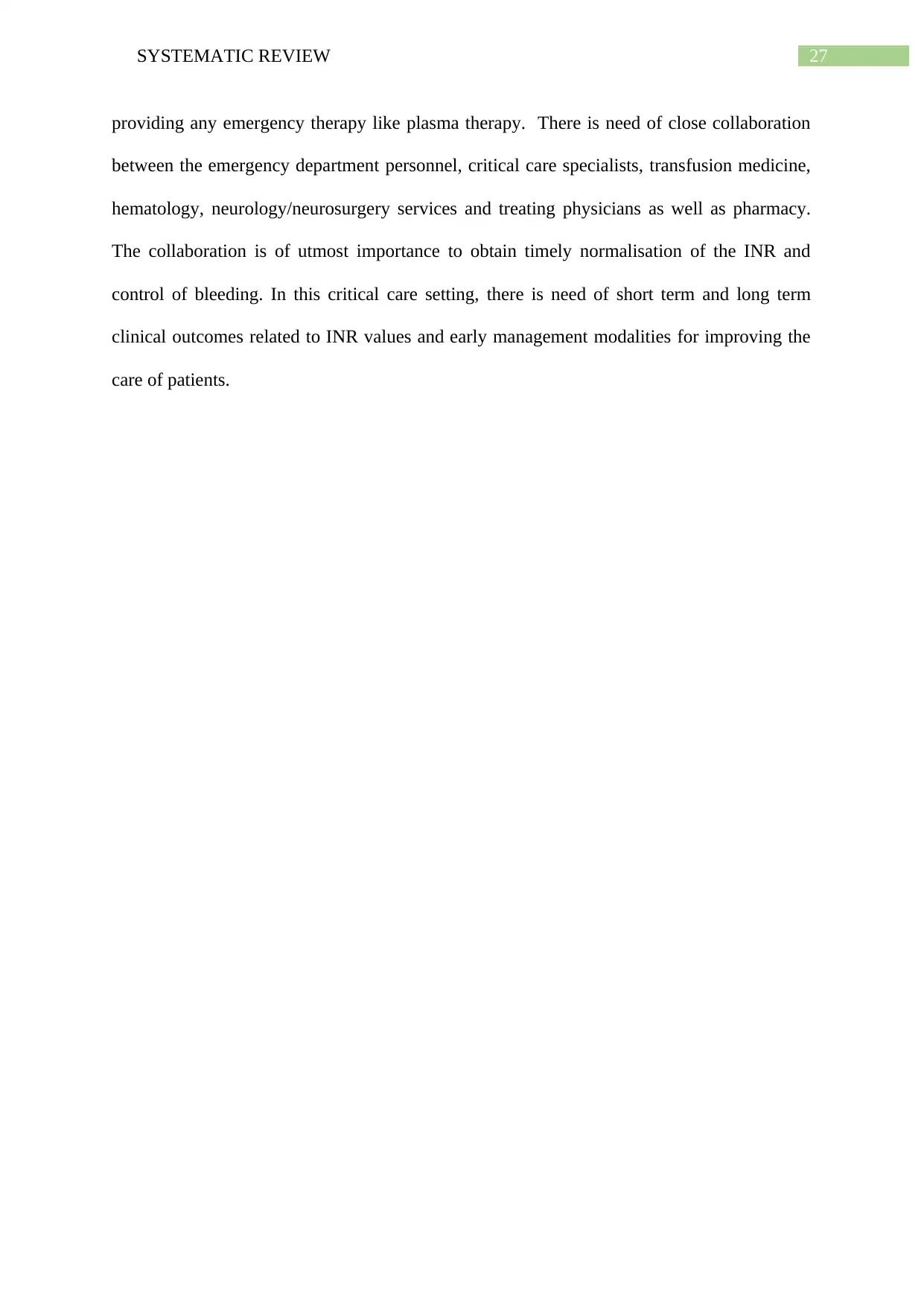
providing any emergency therapy like plasma therapy. There is need of close collaboration
between the emergency department personnel, critical care specialists, transfusion medicine,
hematology, neurology/neurosurgery services and treating physicians as well as pharmacy.
The collaboration is of utmost importance to obtain timely normalisation of the INR and
control of bleeding. In this critical care setting, there is need of short term and long term
clinical outcomes related to INR values and early management modalities for improving the
care of patients.
⊘ This is a preview!⊘
Do you want full access?
Subscribe today to unlock all pages.

Trusted by 1+ million students worldwide
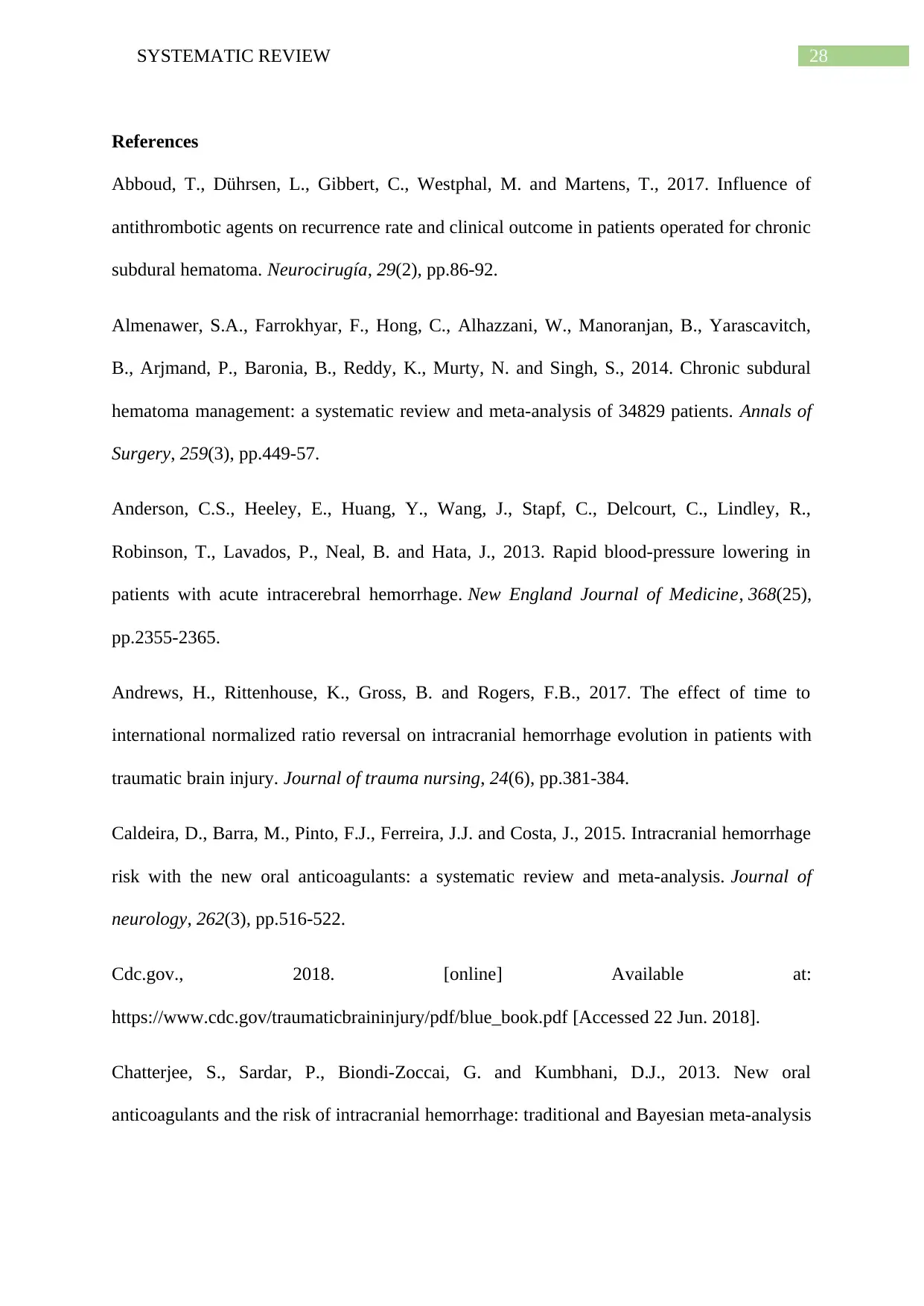
References
Abboud, T., Dührsen, L., Gibbert, C., Westphal, M. and Martens, T., 2017. Influence of
antithrombotic agents on recurrence rate and clinical outcome in patients operated for chronic
subdural hematoma. Neurocirugía, 29(2), pp.86-92.
Almenawer, S.A., Farrokhyar, F., Hong, C., Alhazzani, W., Manoranjan, B., Yarascavitch,
B., Arjmand, P., Baronia, B., Reddy, K., Murty, N. and Singh, S., 2014. Chronic subdural
hematoma management: a systematic review and meta-analysis of 34829 patients. Annals of
Surgery, 259(3), pp.449-57.
Anderson, C.S., Heeley, E., Huang, Y., Wang, J., Stapf, C., Delcourt, C., Lindley, R.,
Robinson, T., Lavados, P., Neal, B. and Hata, J., 2013. Rapid blood-pressure lowering in
patients with acute intracerebral hemorrhage. New England Journal of Medicine, 368(25),
pp.2355-2365.
Andrews, H., Rittenhouse, K., Gross, B. and Rogers, F.B., 2017. The effect of time to
international normalized ratio reversal on intracranial hemorrhage evolution in patients with
traumatic brain injury. Journal of trauma nursing, 24(6), pp.381-384.
Caldeira, D., Barra, M., Pinto, F.J., Ferreira, J.J. and Costa, J., 2015. Intracranial hemorrhage
risk with the new oral anticoagulants: a systematic review and meta-analysis. Journal of
neurology, 262(3), pp.516-522.
Cdc.gov., 2018. [online] Available at:
https://www.cdc.gov/traumaticbraininjury/pdf/blue_book.pdf [Accessed 22 Jun. 2018].
Chatterjee, S., Sardar, P., Biondi-Zoccai, G. and Kumbhani, D.J., 2013. New oral
anticoagulants and the risk of intracranial hemorrhage: traditional and Bayesian meta-analysis
Paraphrase This Document
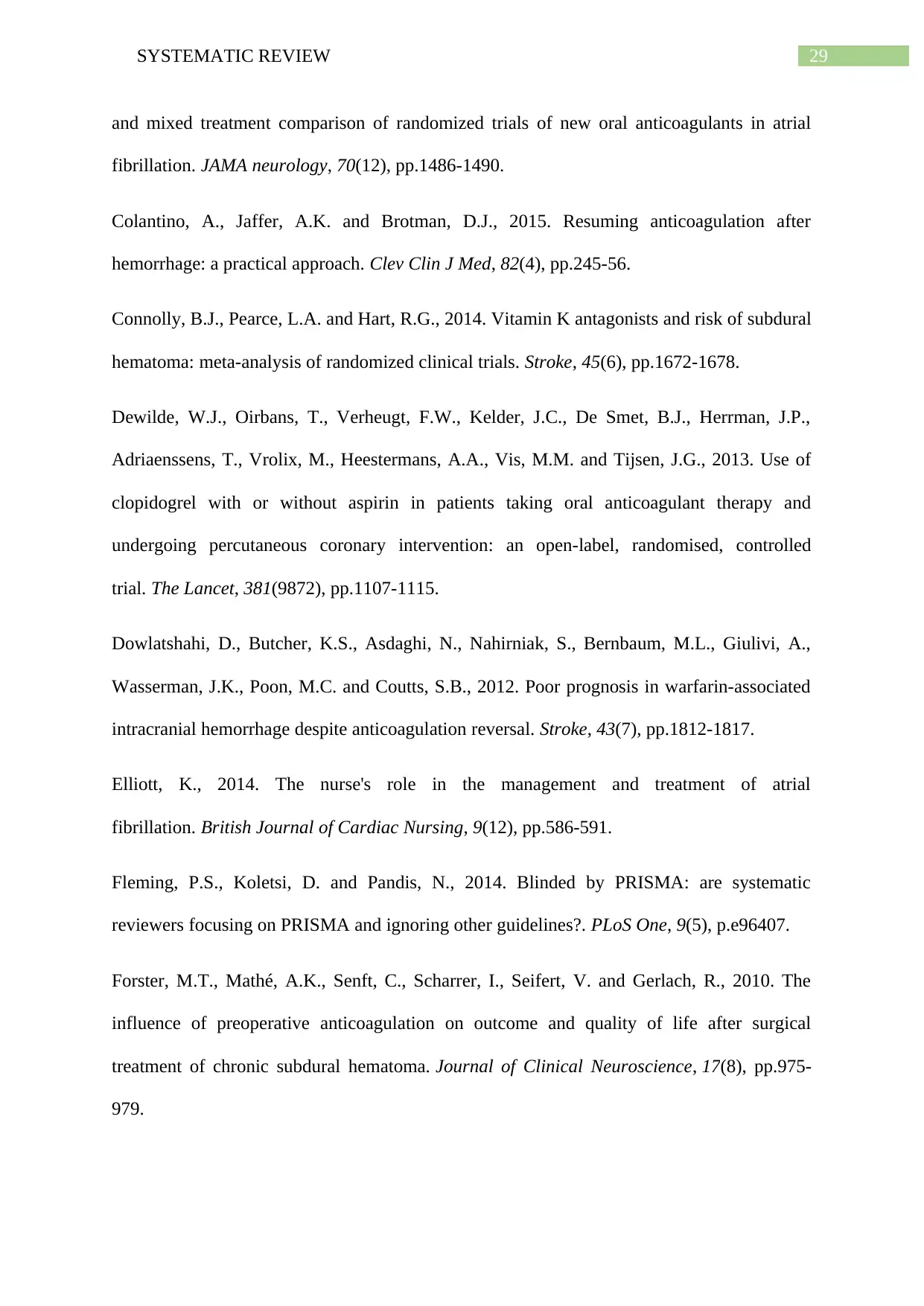
and mixed treatment comparison of randomized trials of new oral anticoagulants in atrial
fibrillation. JAMA neurology, 70(12), pp.1486-1490.
Colantino, A., Jaffer, A.K. and Brotman, D.J., 2015. Resuming anticoagulation after
hemorrhage: a practical approach. Clev Clin J Med, 82(4), pp.245-56.
Connolly, B.J., Pearce, L.A. and Hart, R.G., 2014. Vitamin K antagonists and risk of subdural
hematoma: meta-analysis of randomized clinical trials. Stroke, 45(6), pp.1672-1678.
Dewilde, W.J., Oirbans, T., Verheugt, F.W., Kelder, J.C., De Smet, B.J., Herrman, J.P.,
Adriaenssens, T., Vrolix, M., Heestermans, A.A., Vis, M.M. and Tijsen, J.G., 2013. Use of
clopidogrel with or without aspirin in patients taking oral anticoagulant therapy and
undergoing percutaneous coronary intervention: an open-label, randomised, controlled
trial. The Lancet, 381(9872), pp.1107-1115.
Dowlatshahi, D., Butcher, K.S., Asdaghi, N., Nahirniak, S., Bernbaum, M.L., Giulivi, A.,
Wasserman, J.K., Poon, M.C. and Coutts, S.B., 2012. Poor prognosis in warfarin-associated
intracranial hemorrhage despite anticoagulation reversal. Stroke, 43(7), pp.1812-1817.
Elliott, K., 2014. The nurse's role in the management and treatment of atrial
fibrillation. British Journal of Cardiac Nursing, 9(12), pp.586-591.
Fleming, P.S., Koletsi, D. and Pandis, N., 2014. Blinded by PRISMA: are systematic
reviewers focusing on PRISMA and ignoring other guidelines?. PLoS One, 9(5), p.e96407.
Forster, M.T., Mathé, A.K., Senft, C., Scharrer, I., Seifert, V. and Gerlach, R., 2010. The
influence of preoperative anticoagulation on outcome and quality of life after surgical
treatment of chronic subdural hematoma. Journal of Clinical Neuroscience, 17(8), pp.975-
979.
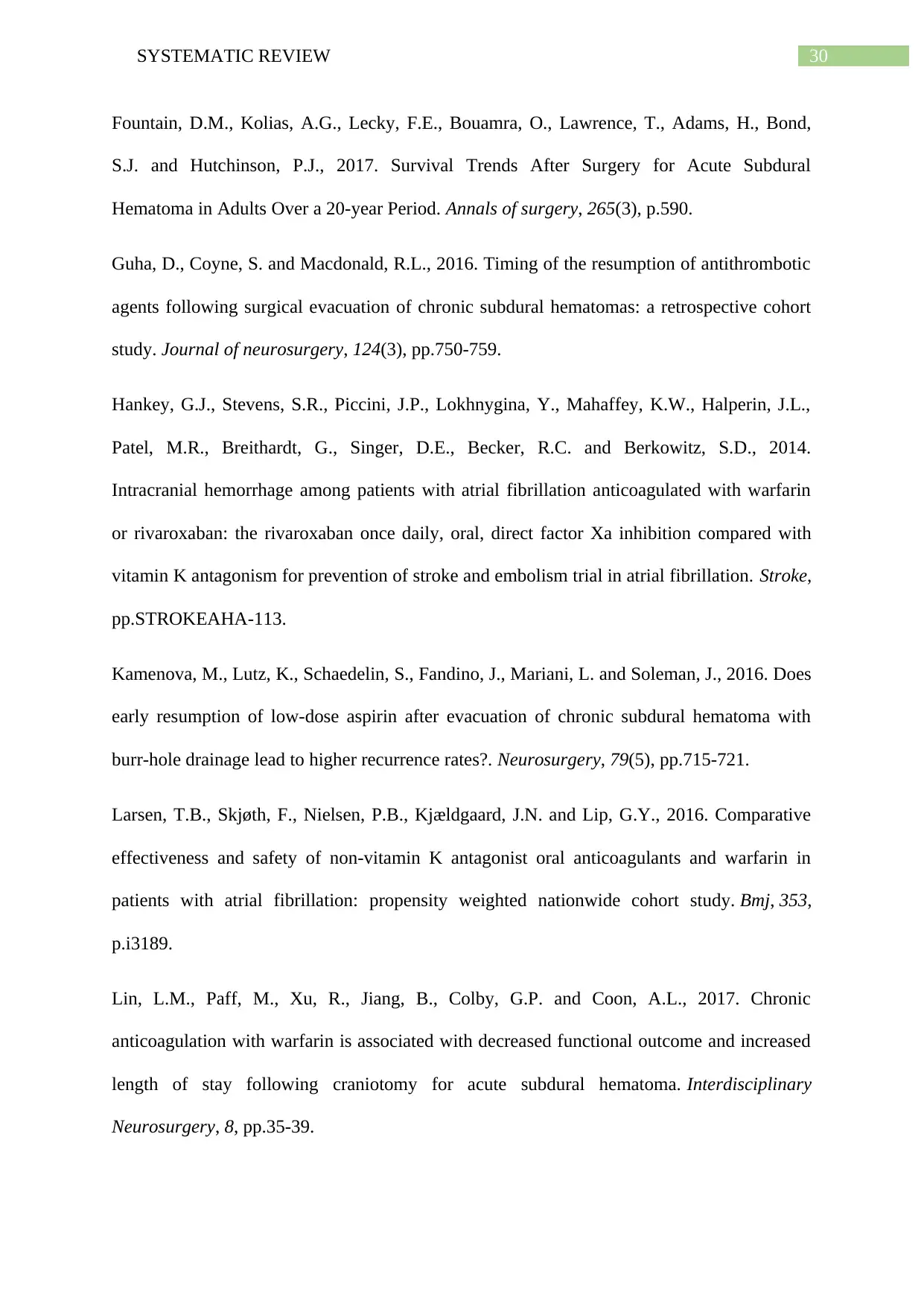
Fountain, D.M., Kolias, A.G., Lecky, F.E., Bouamra, O., Lawrence, T., Adams, H., Bond,
S.J. and Hutchinson, P.J., 2017. Survival Trends After Surgery for Acute Subdural
Hematoma in Adults Over a 20-year Period. Annals of surgery, 265(3), p.590.
Guha, D., Coyne, S. and Macdonald, R.L., 2016. Timing of the resumption of antithrombotic
agents following surgical evacuation of chronic subdural hematomas: a retrospective cohort
study. Journal of neurosurgery, 124(3), pp.750-759.
Hankey, G.J., Stevens, S.R., Piccini, J.P., Lokhnygina, Y., Mahaffey, K.W., Halperin, J.L.,
Patel, M.R., Breithardt, G., Singer, D.E., Becker, R.C. and Berkowitz, S.D., 2014.
Intracranial hemorrhage among patients with atrial fibrillation anticoagulated with warfarin
or rivaroxaban: the rivaroxaban once daily, oral, direct factor Xa inhibition compared with
vitamin K antagonism for prevention of stroke and embolism trial in atrial fibrillation. Stroke,
pp.STROKEAHA-113.
Kamenova, M., Lutz, K., Schaedelin, S., Fandino, J., Mariani, L. and Soleman, J., 2016. Does
early resumption of low-dose aspirin after evacuation of chronic subdural hematoma with
burr-hole drainage lead to higher recurrence rates?. Neurosurgery, 79(5), pp.715-721.
Larsen, T.B., Skjøth, F., Nielsen, P.B., Kjældgaard, J.N. and Lip, G.Y., 2016. Comparative
effectiveness and safety of non-vitamin K antagonist oral anticoagulants and warfarin in
patients with atrial fibrillation: propensity weighted nationwide cohort study. Bmj, 353,
p.i3189.
Lin, L.M., Paff, M., Xu, R., Jiang, B., Colby, G.P. and Coon, A.L., 2017. Chronic
anticoagulation with warfarin is associated with decreased functional outcome and increased
length of stay following craniotomy for acute subdural hematoma. Interdisciplinary
Neurosurgery, 8, pp.35-39.
⊘ This is a preview!⊘
Do you want full access?
Subscribe today to unlock all pages.

Trusted by 1+ million students worldwide
Your All-in-One AI-Powered Toolkit for Academic Success.
+13062052269
info@desklib.com
Available 24*7 on WhatsApp / Email
![[object Object]](/_next/static/media/star-bottom.7253800d.svg)
© 2024 | Zucol Services PVT LTD | All rights reserved.

